European hamsters are small mammals commonly seen in specific places in Vienna. Although Vienna is a large city, it is a hot spot for wildlife watchers. As I heard about these European hamsters in a documentary, I decided to visit the city at the beginning of last July. I had a splendid time with these small mammals, and thus, dream already about my next visit. In this blog entry I write more about my experiences with these European hamsters at the Central Cemetery in Vienna.
Urban wildlife in Vienna
The Viennese Stephansdom. The Prater. Or the Schönbrunn Palace. Vienna is a heaven for architecture, art or culture fans. Who would think of a wildlife safari or something like that in Vienna in the first place? Well...
... I for one.
But I have to tell you that most people looked at me somewhat amused when I told them about my intention to visit Vienna to see the European hamsters on the Central Cemetery.
“You go to Vienna to visit a cemetery?!”
“Are these hamsters wild?”
“Do you plan to see some more things of Vienna?”
These were some of the questions I was confronted before my visit. Others could hardly believe that my principal goal in Vienna was to see and photograph the European hamsters on a cemetery. And to see the European ground squirrels. And hopefully some more wildlife!
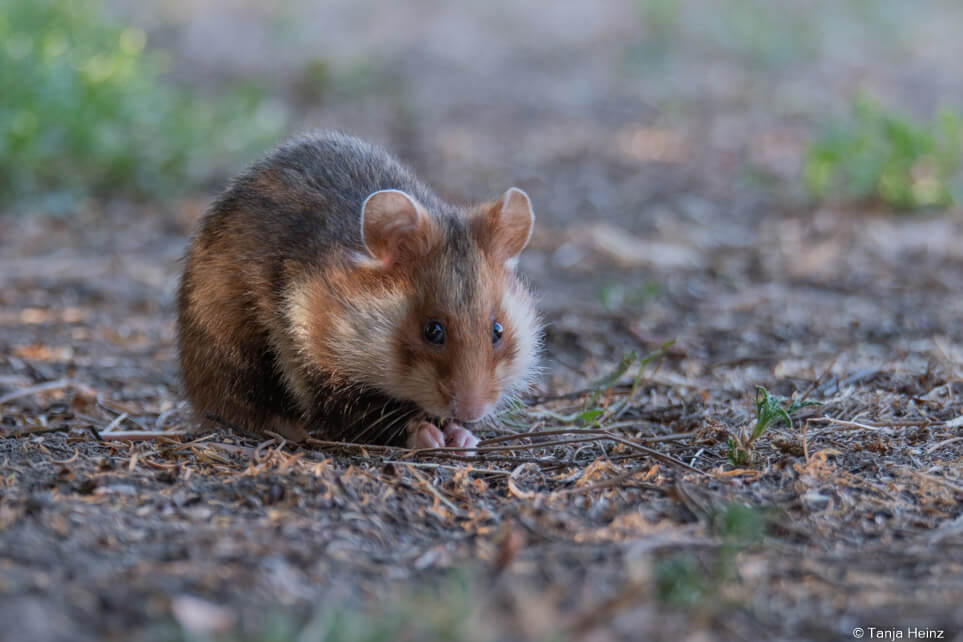
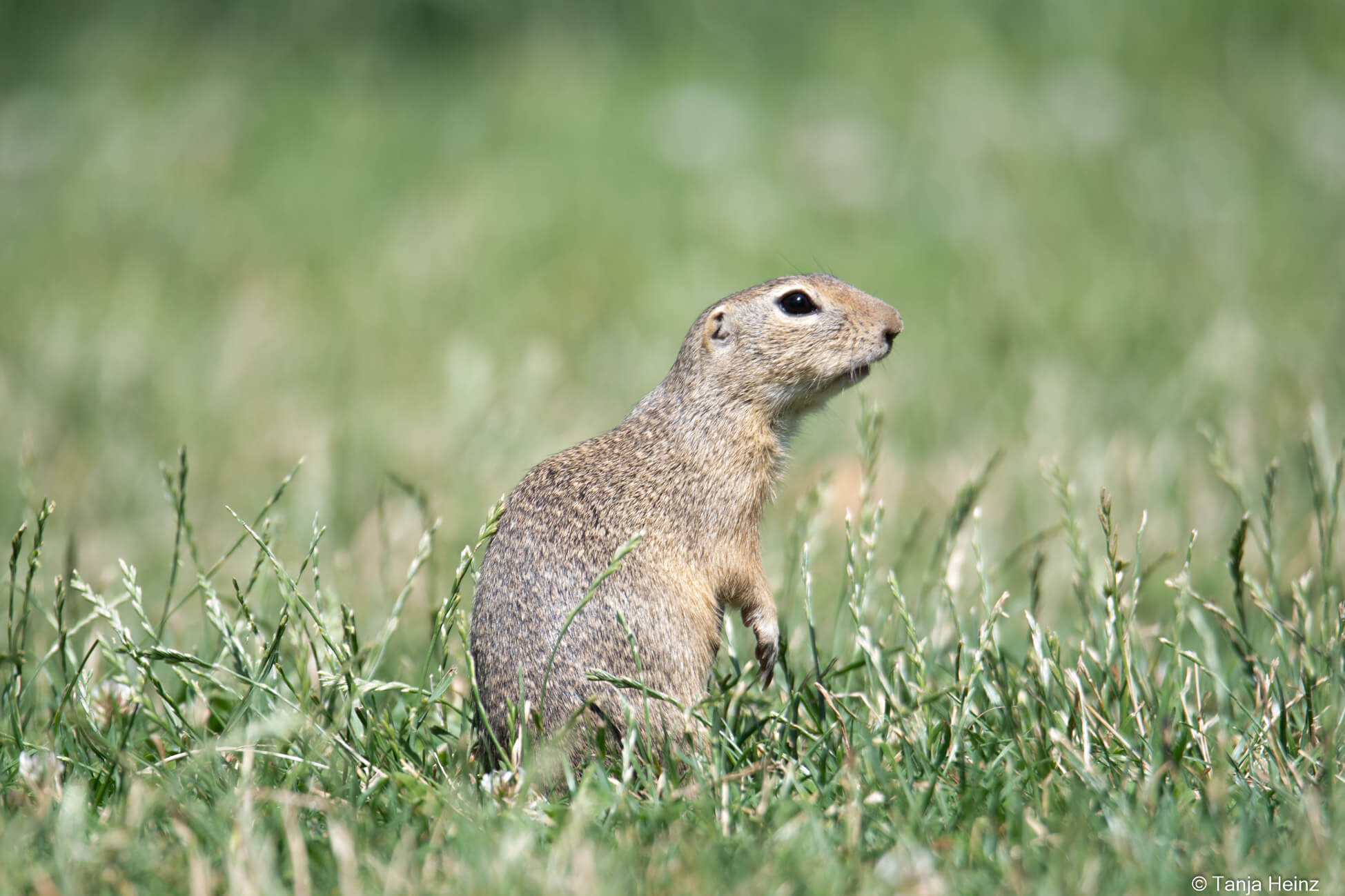
Vienna is not only a great place for people interested in architecture, art or culture. It is also a great place for wildlife enthusiasts like me.
Including bird watchers.
However, I have to admit that on my visit in Vienna I couldn’t spot that many birds. But of course, I saw some. Like a Eurasian kestrel on a meadow of the Central Cemetery.
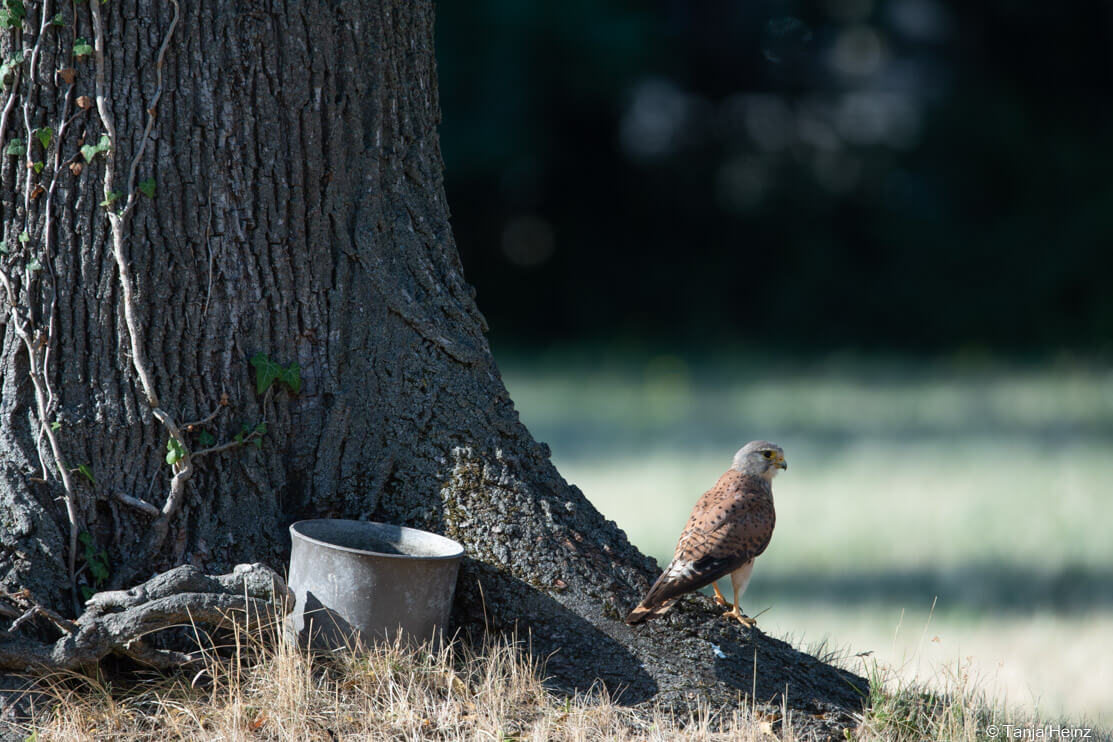
But the European hamsters are probably the most famous wildlife of Vienna. Especially among wildlife photographers.
Another interesting animal is the European hare. When I was searching for the European ground squirrels, I saw a European hare searching for a cooler place in the shadow. But the European hare disappeared again as quickly as it has arrived.
Too bad.
I was not ready with my camera and got only a blurry photograph. But still it was a very special encounter as I don’t see European hares frequently...
Instead of taking photographs of that European hare, I could focus on some mute swans which were passing by in the river just next to the path.
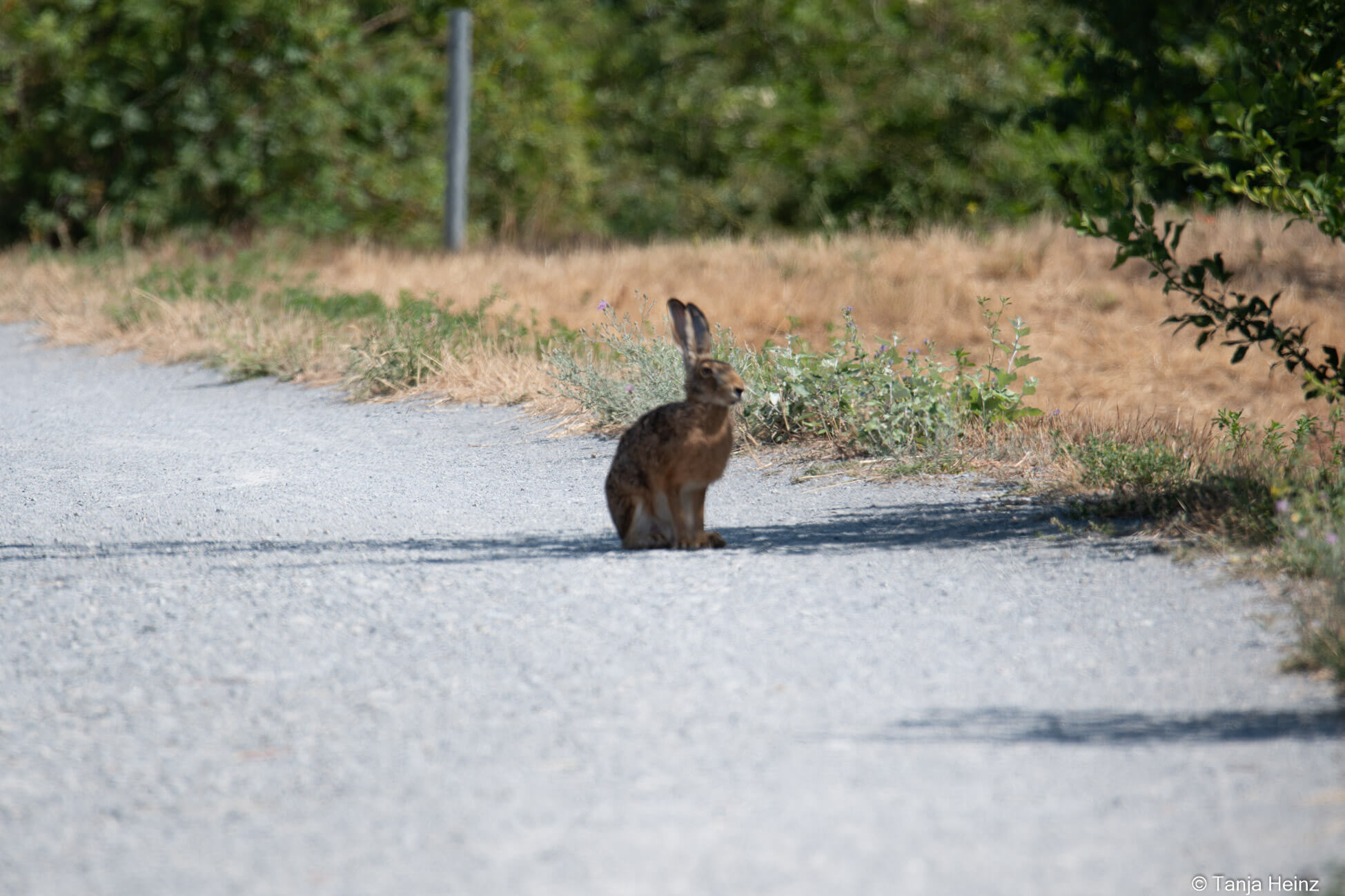
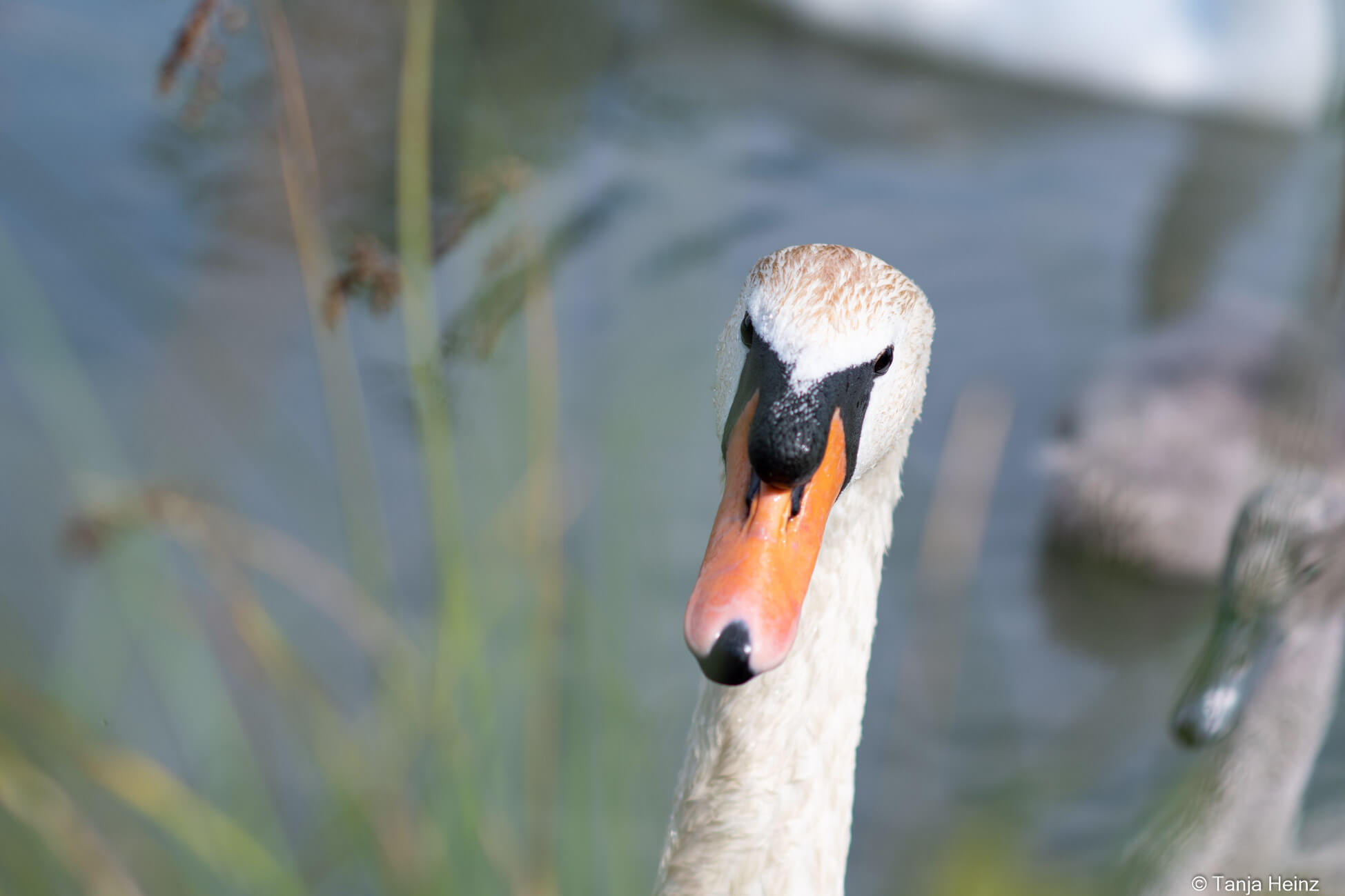
As I was in Vienna for just three days (definitely too short for Vienna), I unfortunately had not the chance to visit all the places I wished to see.
Like the Wasserpark Floridsdorf where wildlife watchers can see a colony of breeding grey herons. Or the Danube Island (Donauinsel) and its king fishers. Or the Lainzer Tiergarten - a wildlife preserve - in the southwest of Vienna.
Just to name a few.
Hedgehogs, beavers (on the photo, taken in the Tiergarten of Berlin), foxes, roe deer, Eurasian red squirrels, European hares, European toads and many more animals have found a home in the city of Vienna.
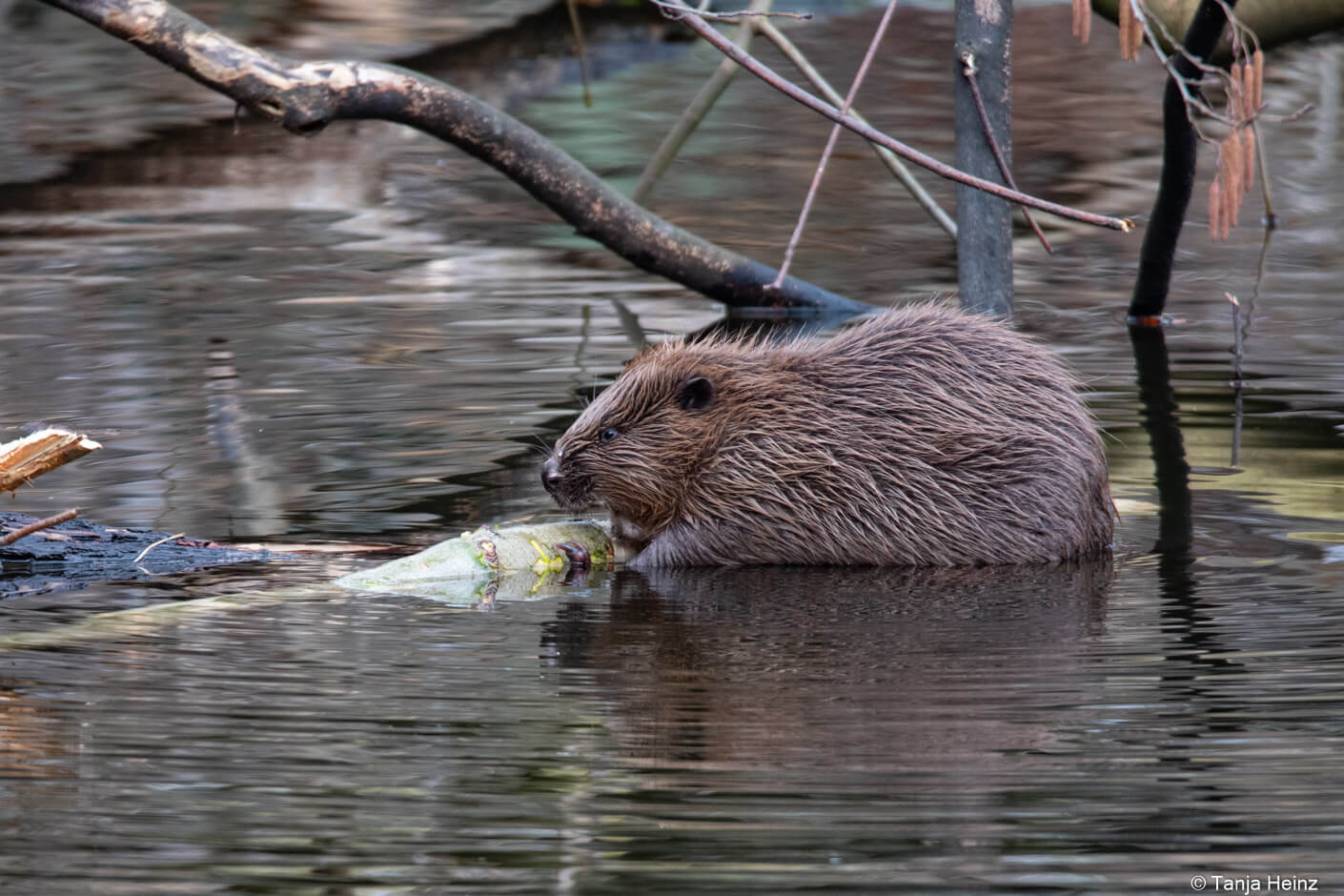
Unfortunately, most of these animals I haven’t seen.
As Vienna is indeed a great wildlife hot spot, I very wish to visit this wonderful city again to spot some more wildlife. In the next paragraph I write about my experiences with the European hamsters on the Central Cemetery.
Tip: If you want to know more about the Viennese wildlife, please check the following blog #daheimistlangweilig. Blumengärten Hirschstetten, by the way, is indeed a great place to see wild European ground squirrels. Please check Wiener Wildnis to get even more tips about wildlife in Vienna.
European hamsters in Vienna
Where do I have to look for the European hamsters at the Central Cemetery in Vienna? Do I have to enter at gate 1 or gate 2? When are the European hamsters most active?
I knew that they are nocturnal or crepuscular, and thus, usually active during the night or at twilight. But do the European hamsters at the Central Cemetery behave like “wild” animals?
Another question.
Due to the fact that these European hamsters live so close to humans, can we still consider these animals as “wild”?
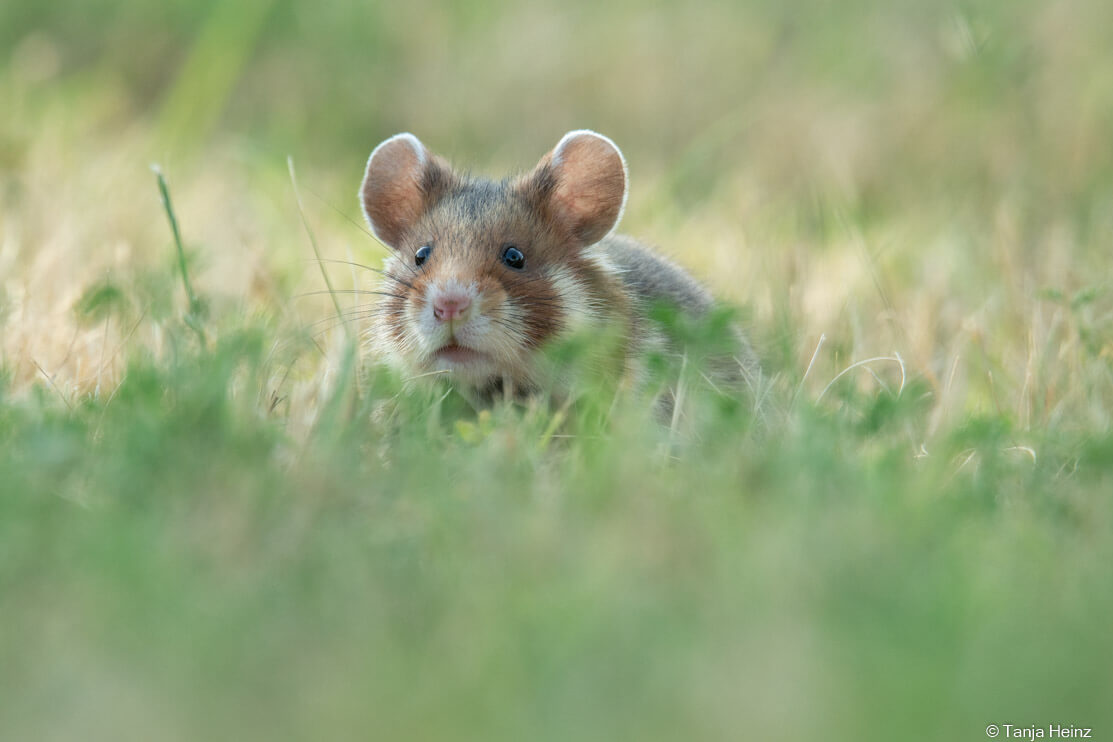
Well, I don’t venture to answer the last question. I’m sure that there are different opinions about this among wildlife watchers or photographers, but probably also among scientists.
Nevertheless, I visited the Central Cemetery in Vienna on a very beautiful (and very hot!) day. I left my accommodation early to be ready for the hamsters when they are most active. However, due to the opening hours of the cemetery I couldn’t be there earlier than 7 a.m.
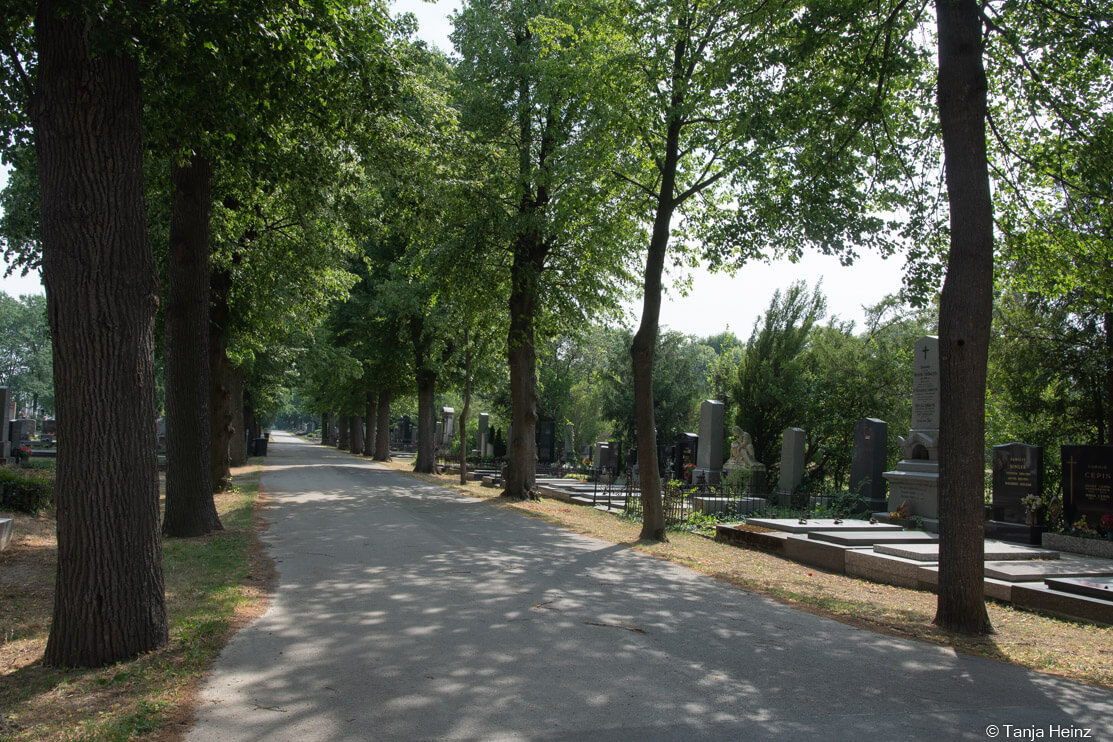
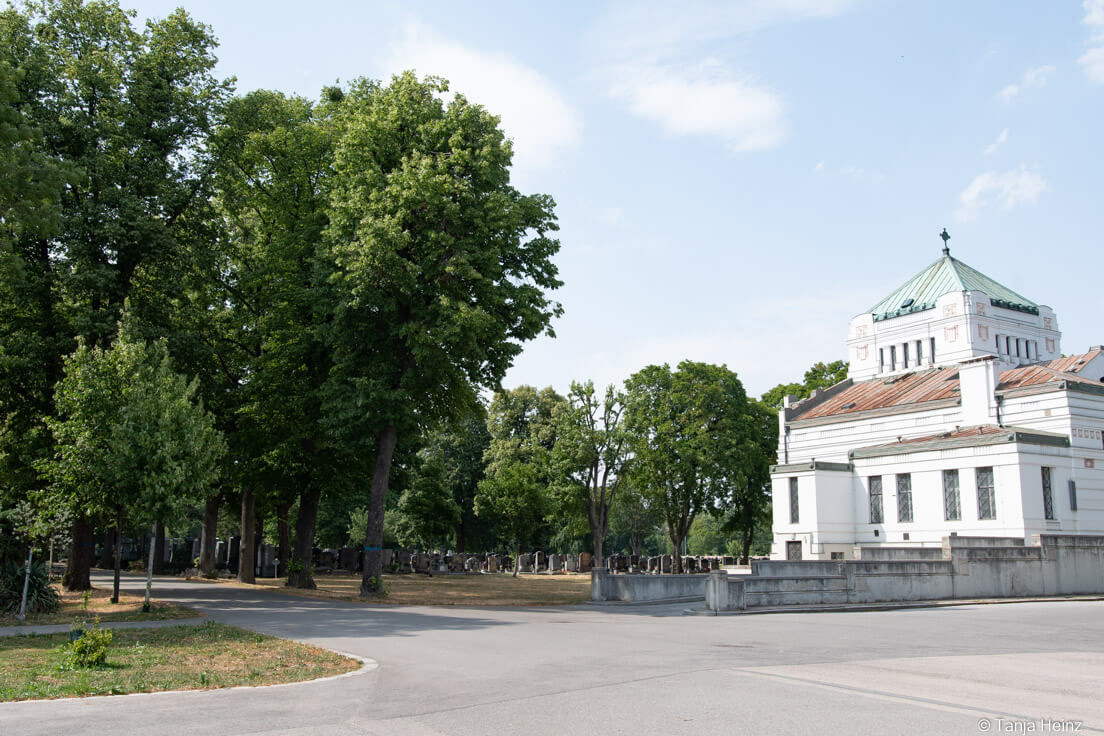
I decided to get off the tram at gate 1. However, as I missed the stop, I got off at gate 2 - the main entrance of the cemetery.
I entered the Central cemetery and I thought about heading to gate 1 by foot, because according to my internet research the cemetery at gate 1 is the place to find most wildlife.
However, when I entered the cemetery, I saw a small something on the meadow.
“Is that already a European hamster?”, I asked myself.
I got closer and closer.
Yes, it was!
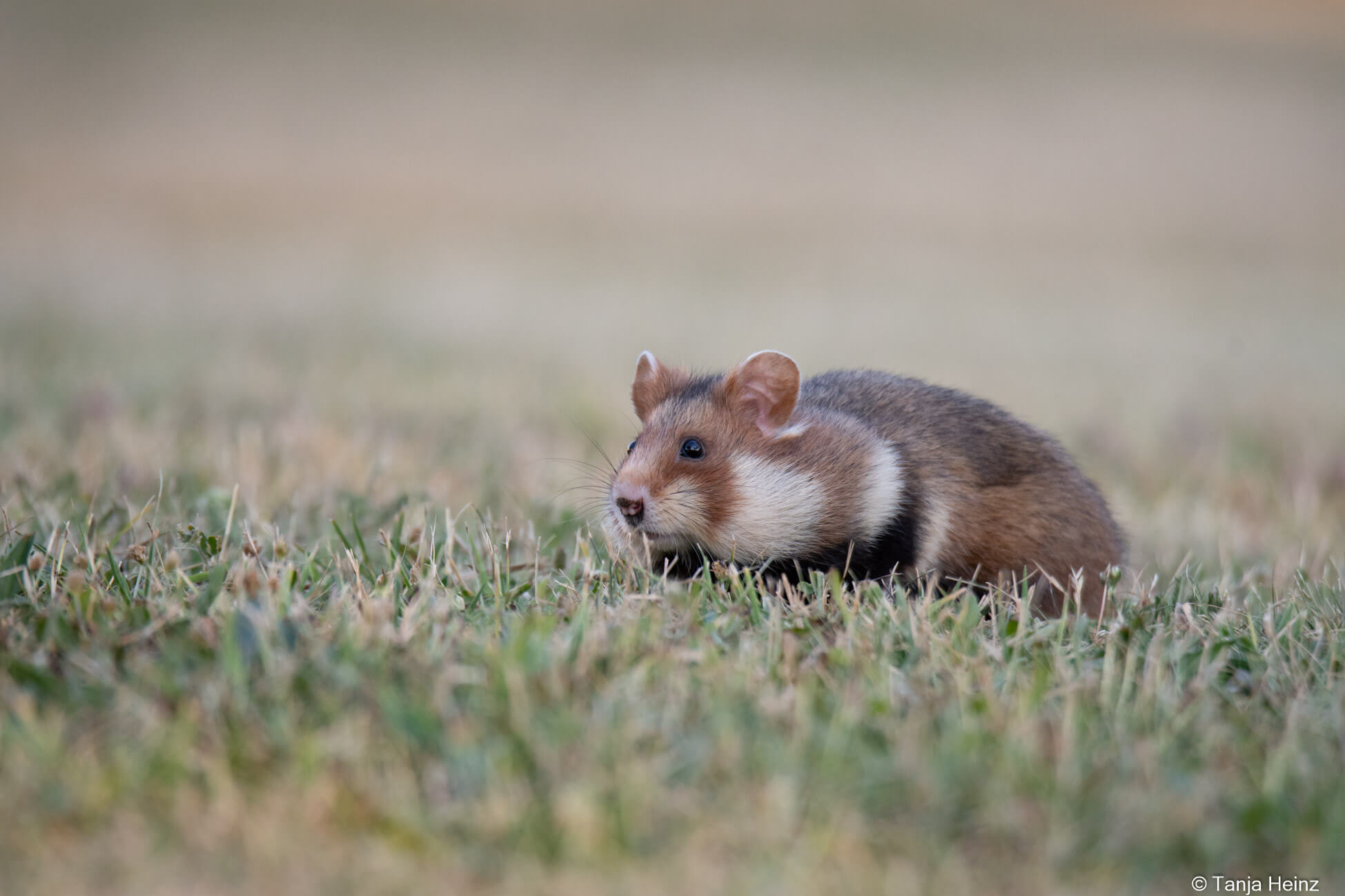
Information: The Central Cemetery in Vienna opens daily. From November to February the cemetery opens its gates from 8 a.m. to 5 p.m. In March and October, the cemetery closes at 6 p.m. But from April to September the opening hours are from 7 a.m. to 7 p.m. On Thursdays the cemetery is even open until 8 p.m., but only from May to August. Please check the website of the Central Cemetery of Vienna to get the most up-to-date information.
And there was not only one of them. There were at least two!
A smaller one and a larger one.
Maybe the smaller hamster was a young of the year?
Given the fact that European hamsters breed between April and August and that the offspring is weaned after already three weeks, it could have been a young of the year.
I saw its smaller and more rounded ears and how its size differed from the other hamster.
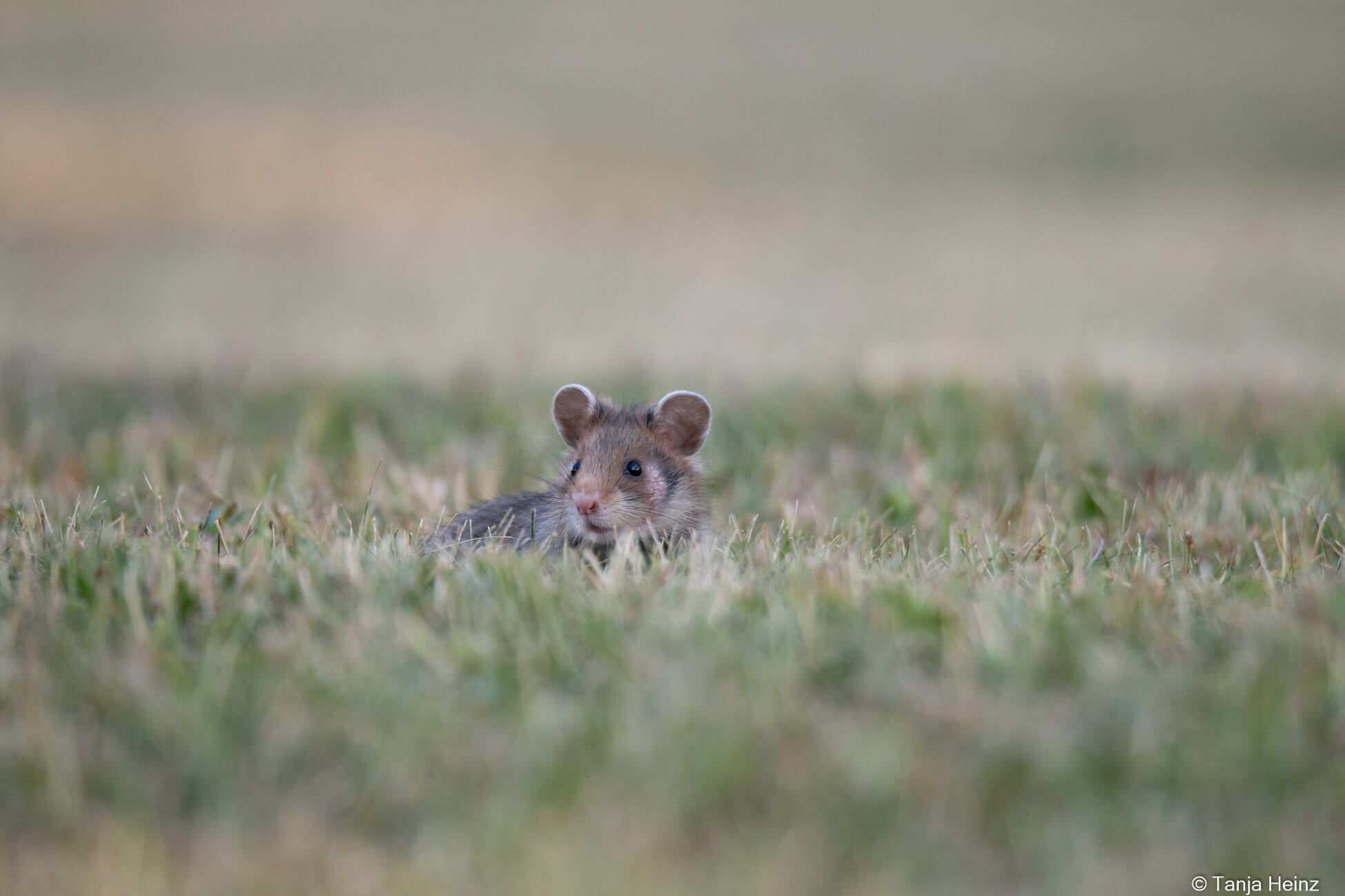
I never (never!) would have thought to spot a European hamster that fast.
I just accepted my luck and enjoyed it. I sat down onto the side of the meadow watching them. For the next moments I didn’t venture to move. Even my camera remained in its bag. Maybe sometimes it is just nicer to only watch and enjoy. Although - I have to admit - it is hard to wait. I tried to keep my restless hands calm in order to not reach out for my camera in the first instance.
As it was a hot day, the meadows at the Central Cemetery were already very dry in the morning. But especially during midday.
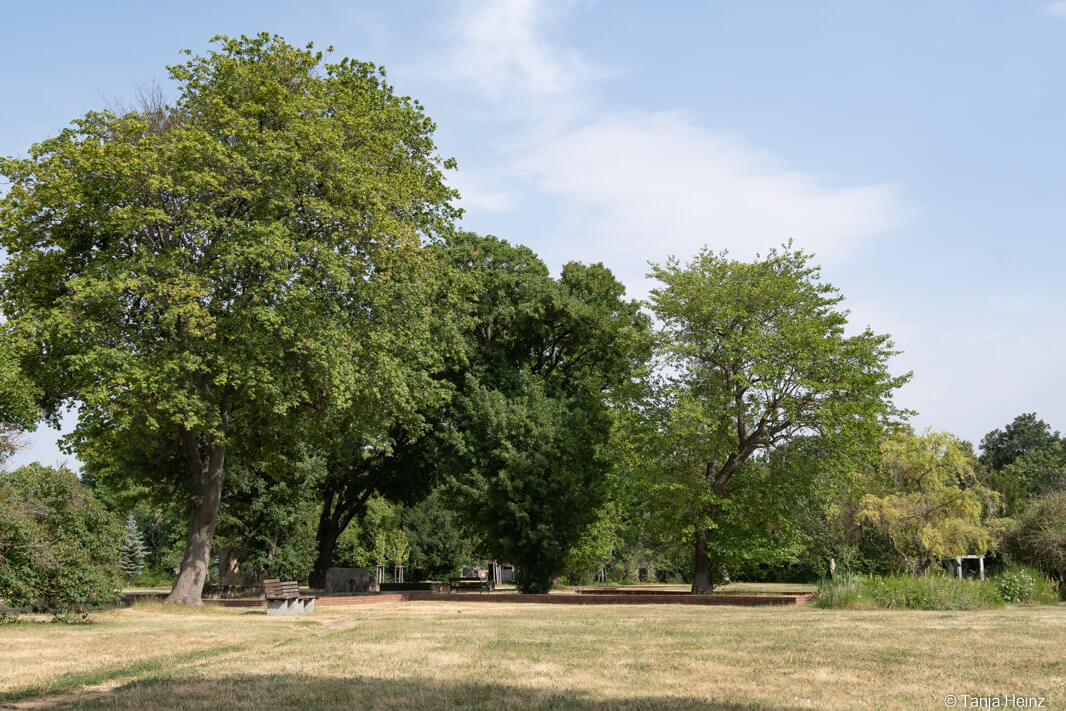
Nevertheless, as a wildlife photographer it is important to be patient and learn when it is the right moment to take a photograph!
After some moments, however, I finally unpacked my bag and prepared my camera.
I lay down on my ventral side to be on eye level with the European hamsters. I took my first photographs of the European hamsters.
Exactly on that meadow I took one of my favorite photograph of the European hamsters during my stay in Vienna.
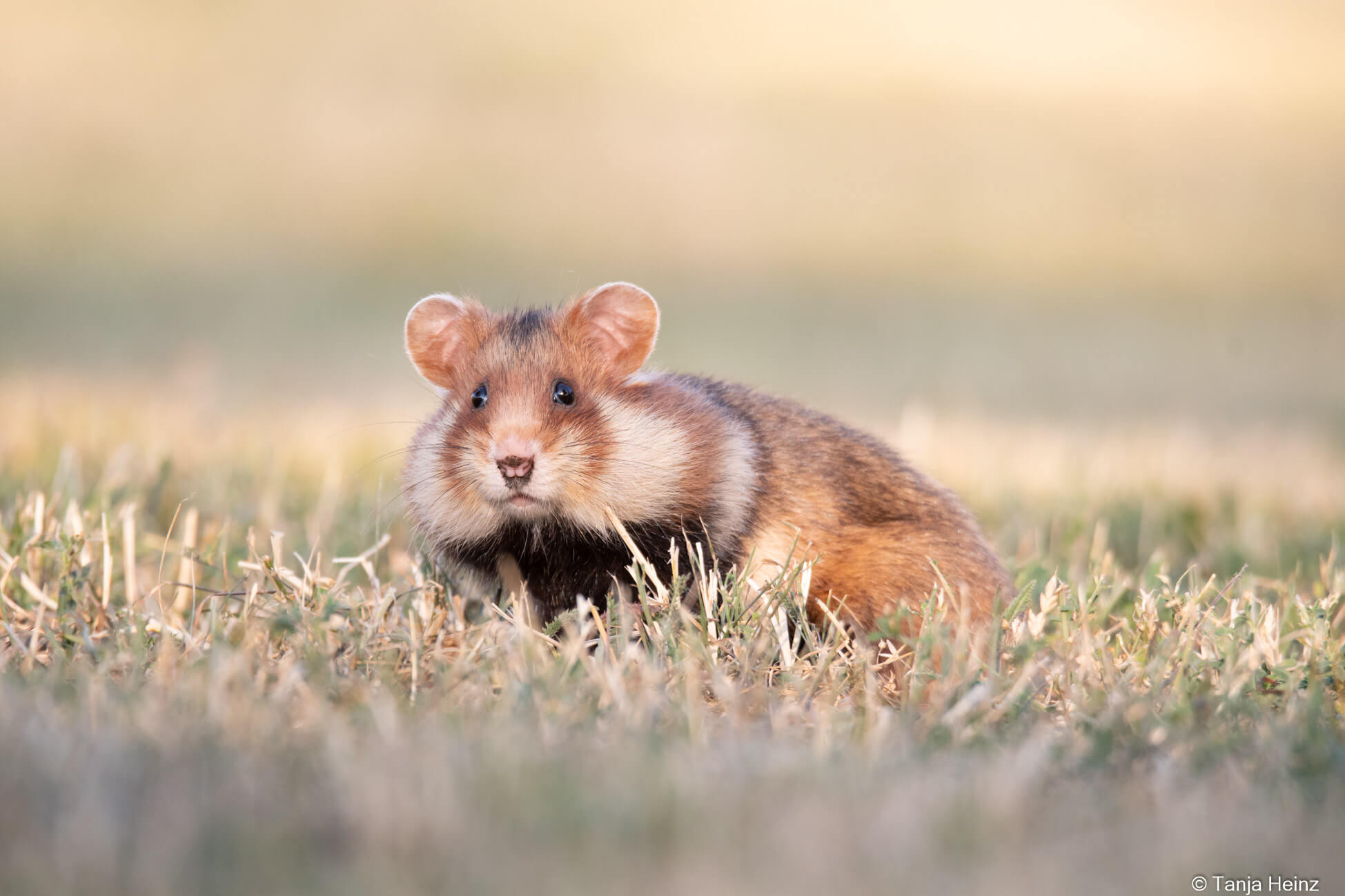
The hamsters seemed to be relaxed. Despite of my presence. For me as a wildlife photographer they were the perfect photo motif in that moment. They didn’t move much. And furthermore, the light was marvelous on that morning.
As I saw European hamsters just after entering the Central Cemetery, I expected to see many more of them later on that day.
And I did.
Here and there I saw a European hamster digging on the ground or just emerging from a hole under a tomb.
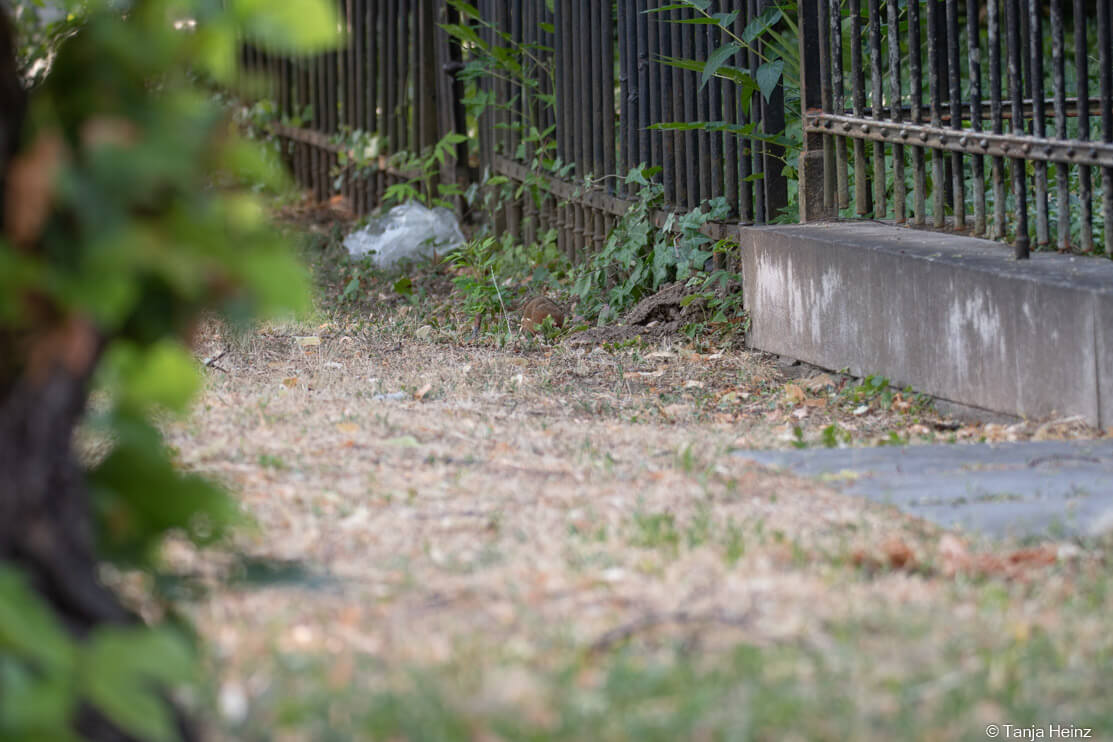
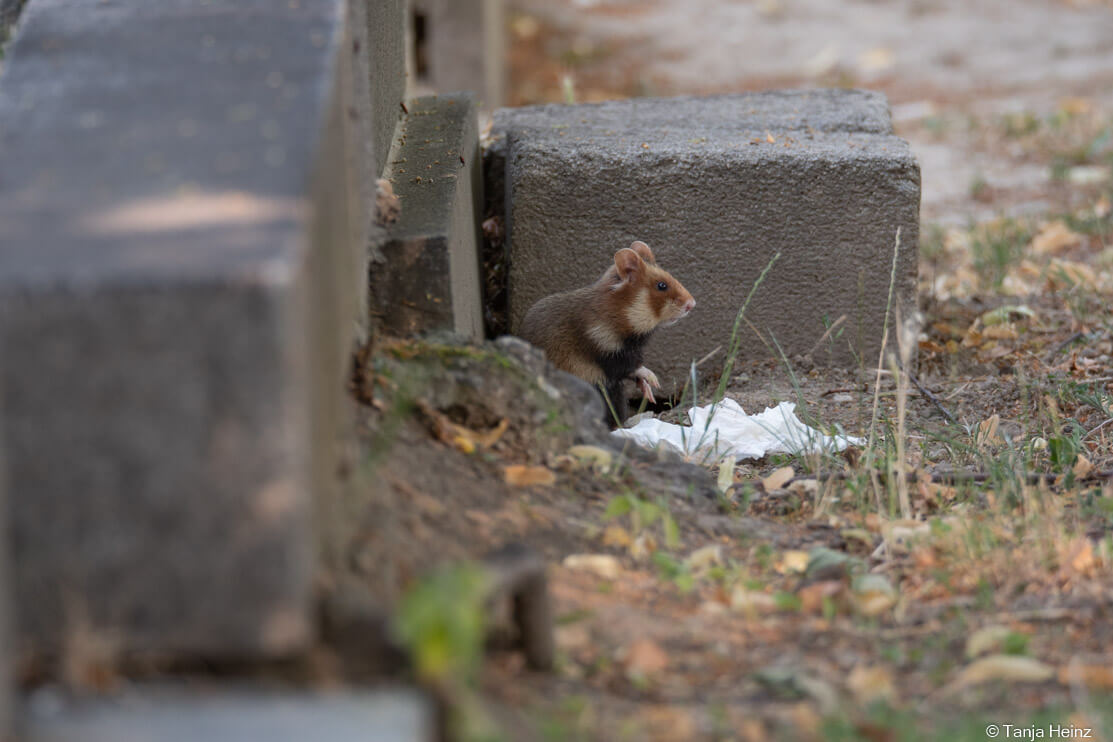
Question: Would you go on a cemetery to photograph wildlife? I asked myself this question and was a little bit worried about that. It was not at all my intention to disturb a cemetery and the people visiting their deceased. How do you feel about that?
But as it was such a hot day, I decided to look for a shady place. I sat down in the shade of a conifer and I waited for some European hamsters to pass by.
Of course, I didn’t have to wait for a long time.
The next European hamster was already around.
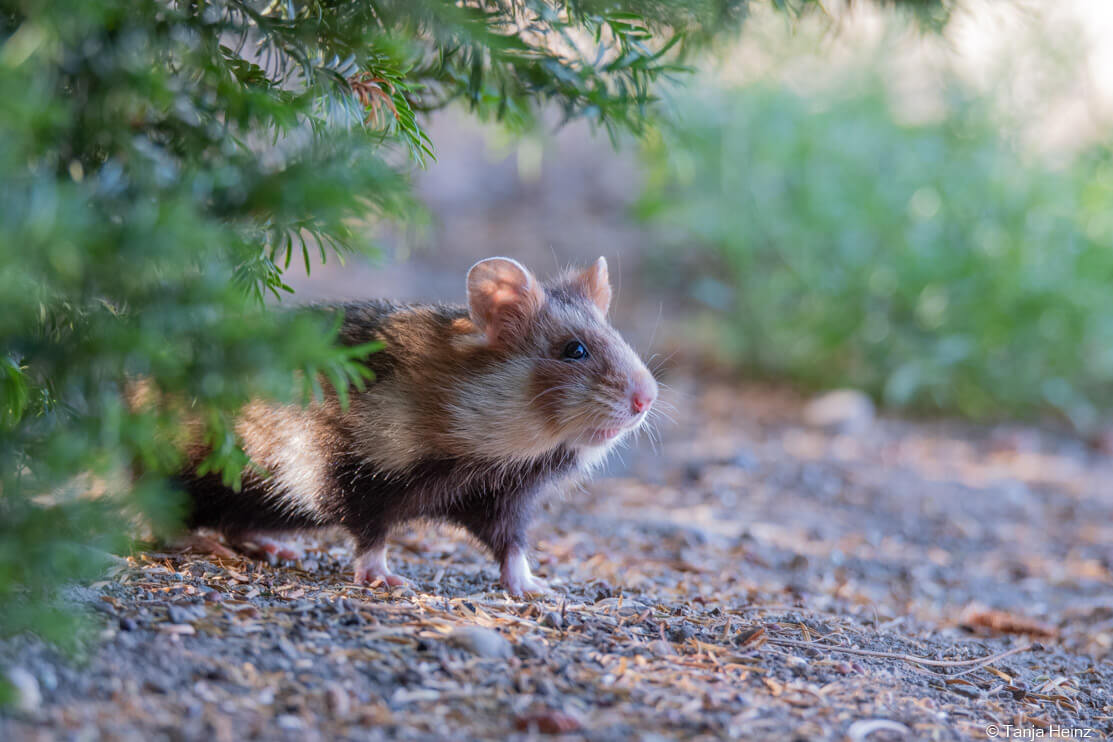
It was a shy hamster and I had to be very, very careful with every movement I made.
Just one movement too much, and the hamster was gone and I had to wait for its return again.
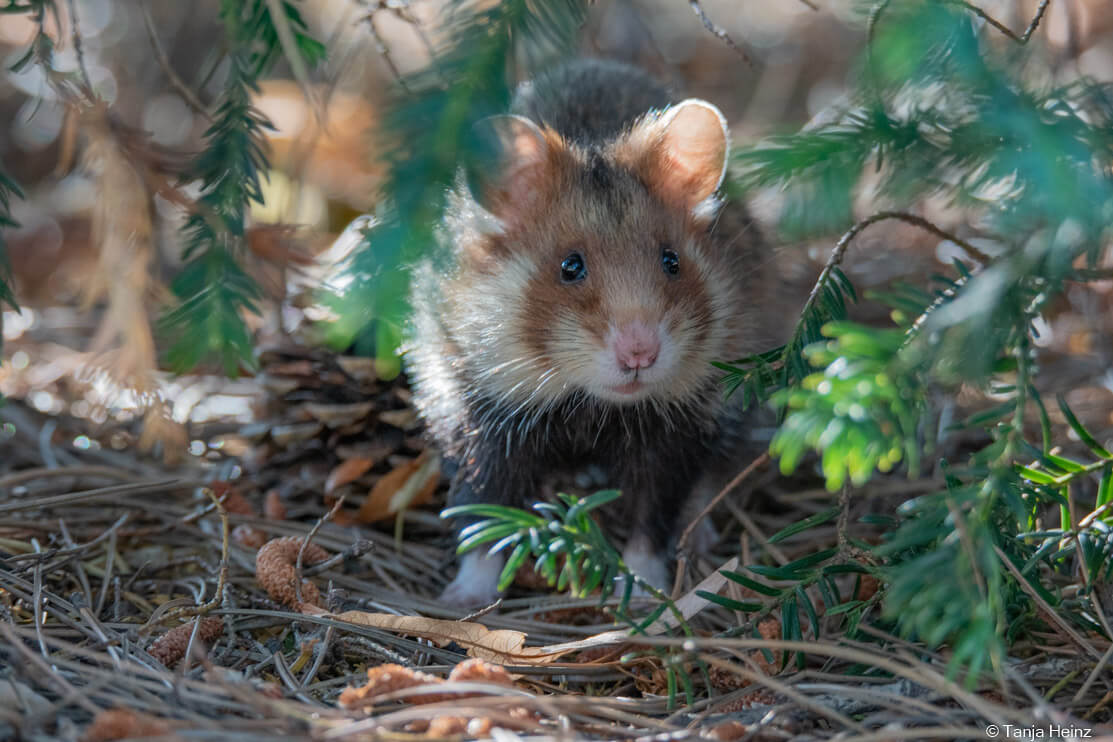
European hamsters have elastic cheek pouches with which they collect food which they store in so-called food storage chambers. They collect food for the winter. They live in a complex borrow system where they hibernate from about October to March. In winter they wake up every 5 to 7 days to feed from the food stored in these storage chambers.
The European hamsters feed mainly on seeds, legumes, root vegetables, grasses, but also insects.
While I was sitting on the meadow watching that hamster under the conifer, the animal was just about to fill its cheek pouches.
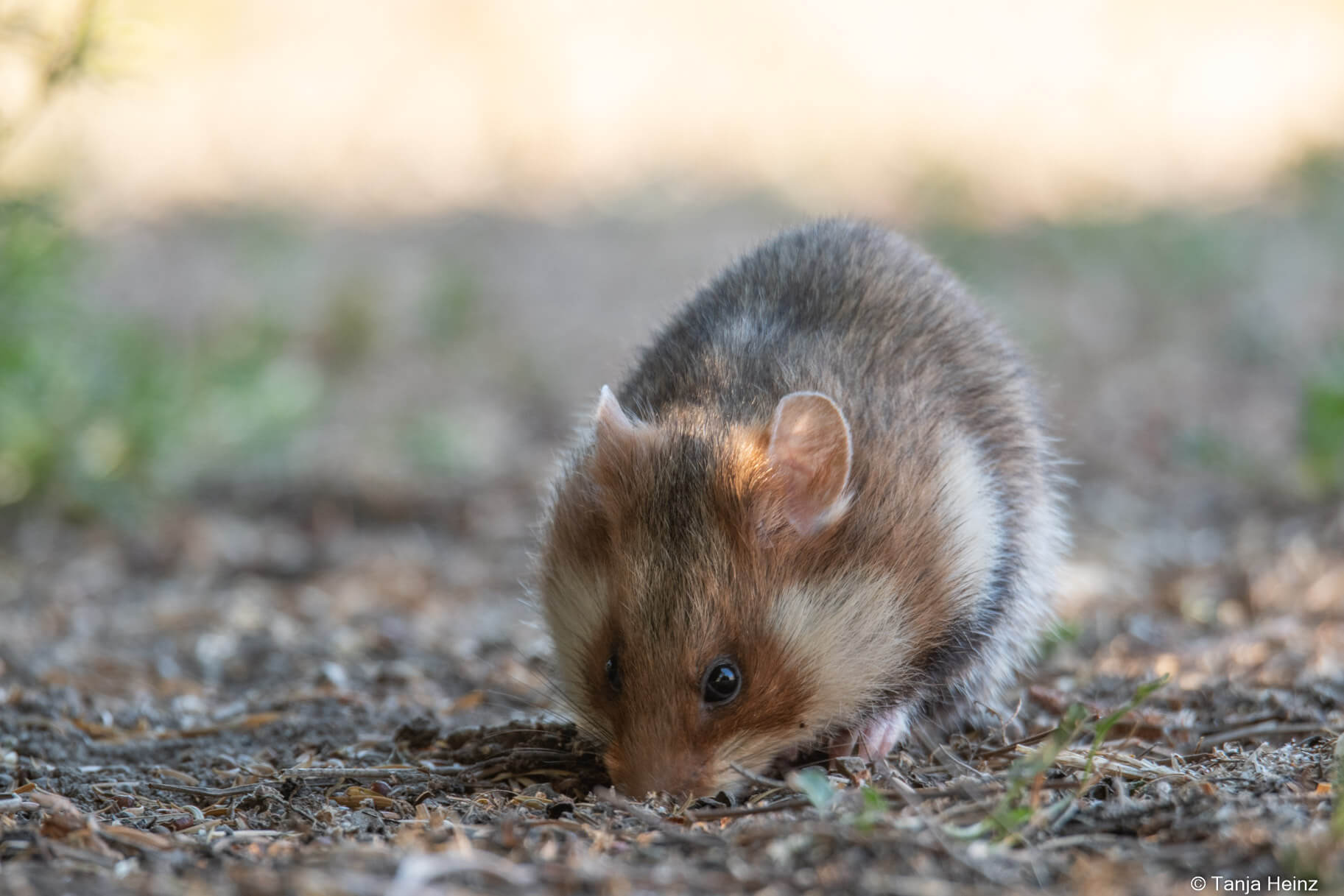
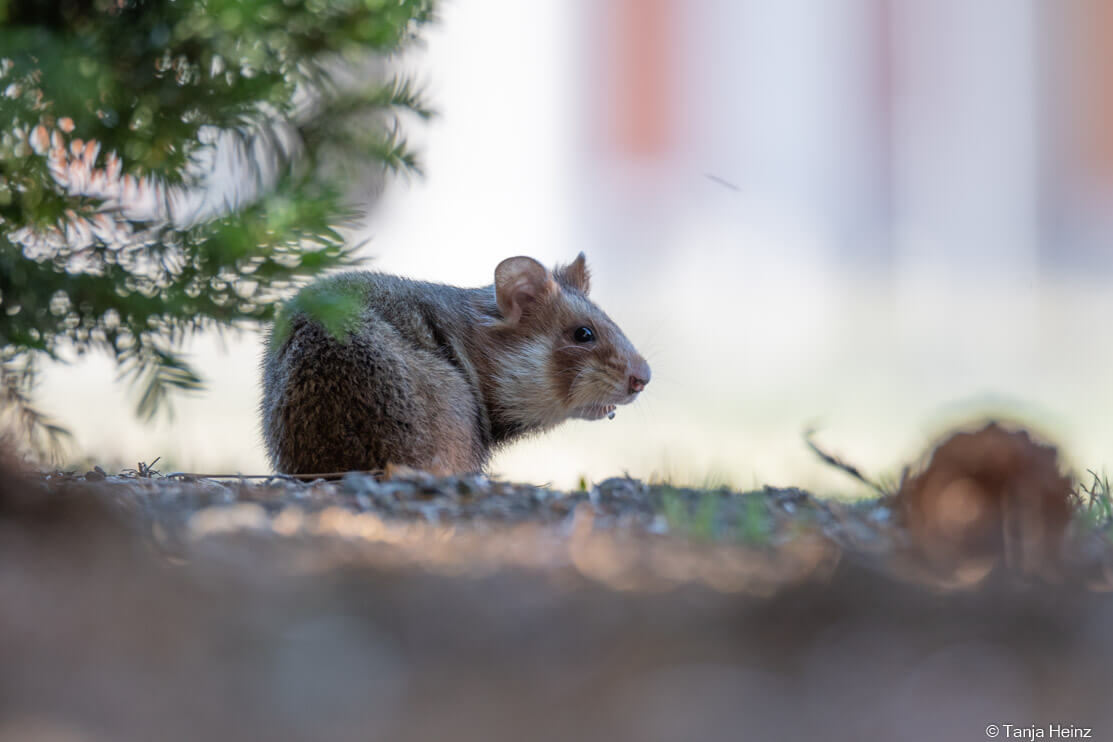
I was fascinated. I felt so lucky to get a glimpse into the life of a European hamster.
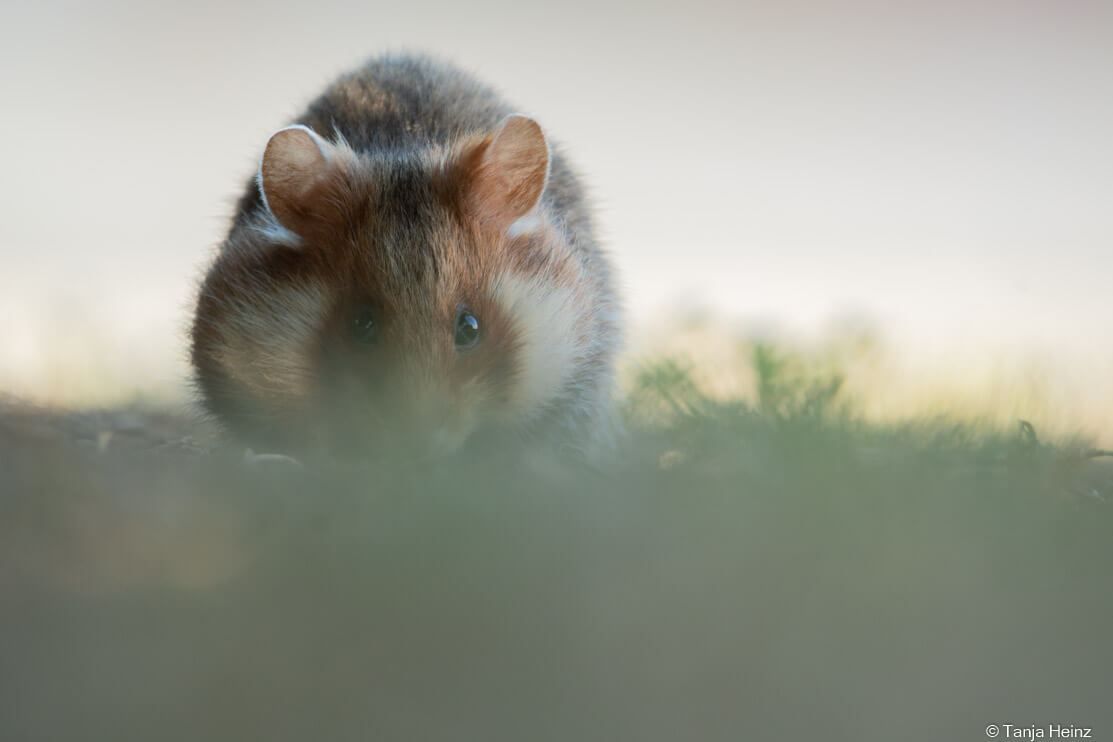
However, when I felt fit again - the heat was too great for me - I got up and walked finally into the direction of gate 1.
Funnily, I didn’t reach gate 1. There was already the next European hamster moving around a tomb.
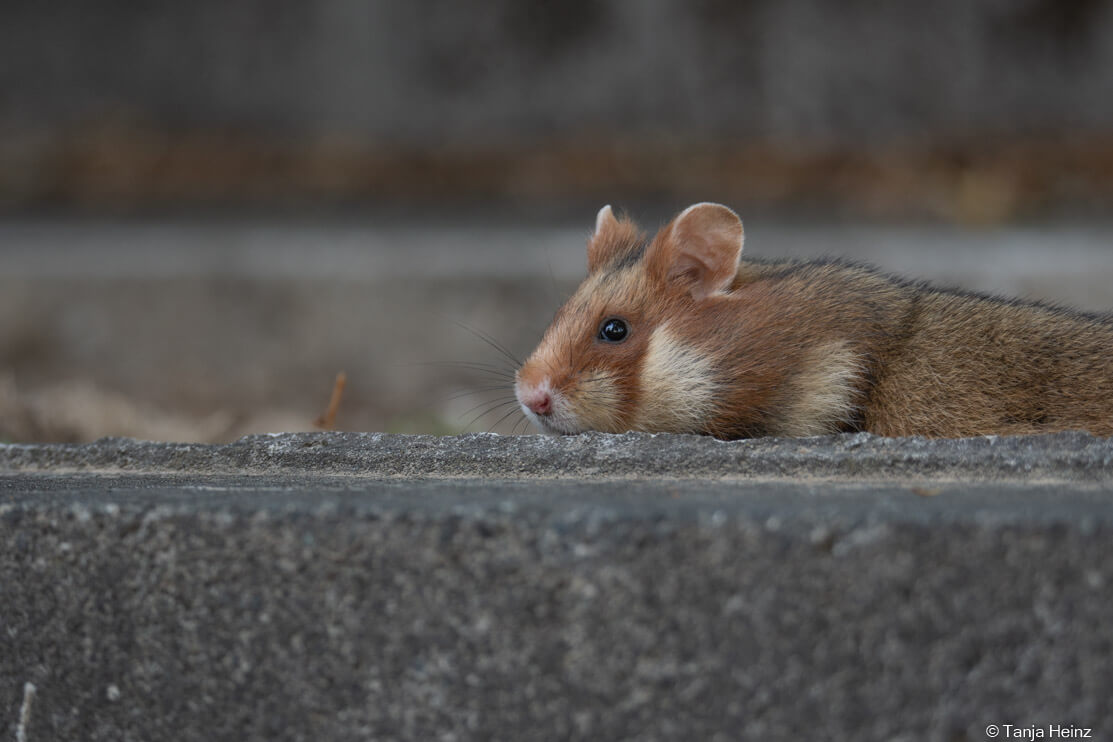
Like the other hamster, that hamster as well was searching for food.
How much time do European hamsters spend foraging on a day? According to a study about the hamsters in Vienna (but not in the Central Cemetery), these animals spend most of the day foraging!
Well, and as it seemed to me on that meadow, these hamsters indeed apparently spend most of the day searching for food.
I sat down on the side of a small paved road and waited for the European hamster to show up again.
And it did!
It was a very, very busy hamster. It was digging around the ground, filling its cheek pouches, disappearing behind the tombs to just emerge again with empty cheek pouches for another foraging round.
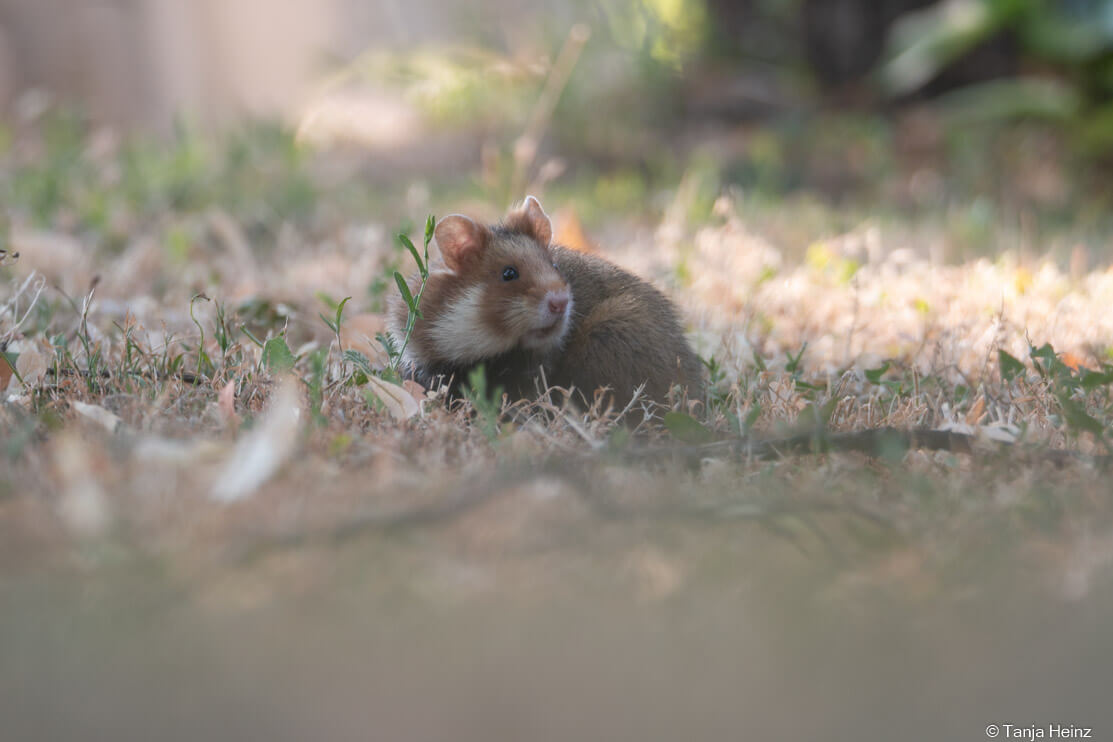
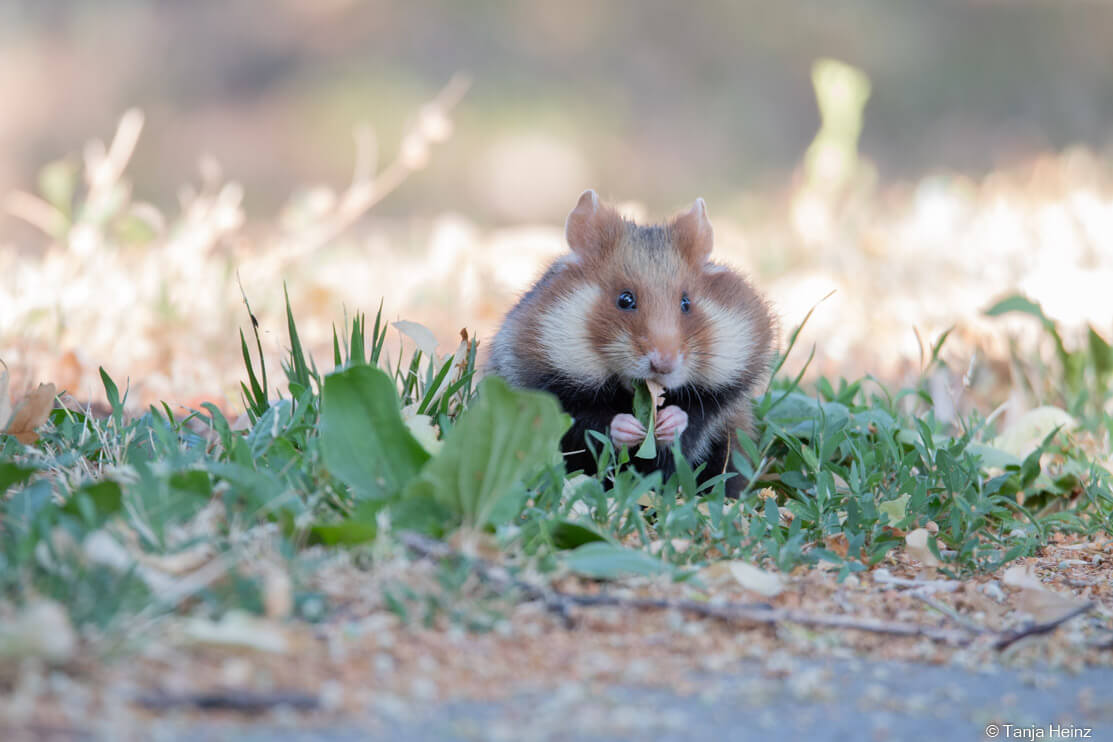
Interesting: Did you know that European hamsters not only live on the Central Cemetery, but also on other cemeteries in Vienna? Please check the website of the city Vienna to get more information about the European hamsters.
I was sitting there for an hour or so. It was just too nice to leave.
Then an Austrian stopped talking to me. I had some difficulties to understand his dialect. But I perceived his passion for photography. He suggested me to go to another place to see many more European hamsters at the Central Cemetery.
A place with even more European hamsters?
I was more than happy to know.
Apparently, the European hamsters are most active in the evening. It is always good to learn such things from local people.
But even more active?
Well, I decided to go back to that other side of gate 2.
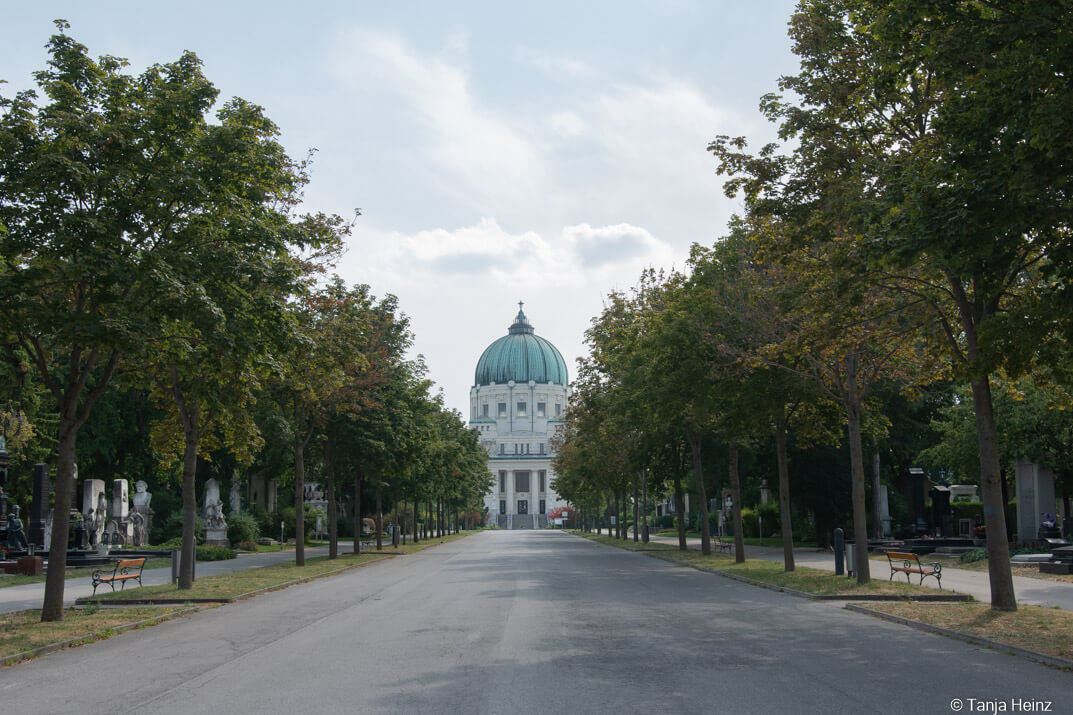
However, as it was already midday, I stayed at that other place only for a few minutes. But I already planned to come back on the next day in the evening.
I only saw a single European hamster close to a garden fence. Maybe the other hamsters had already drawn back avoiding the sun and heat of the day.
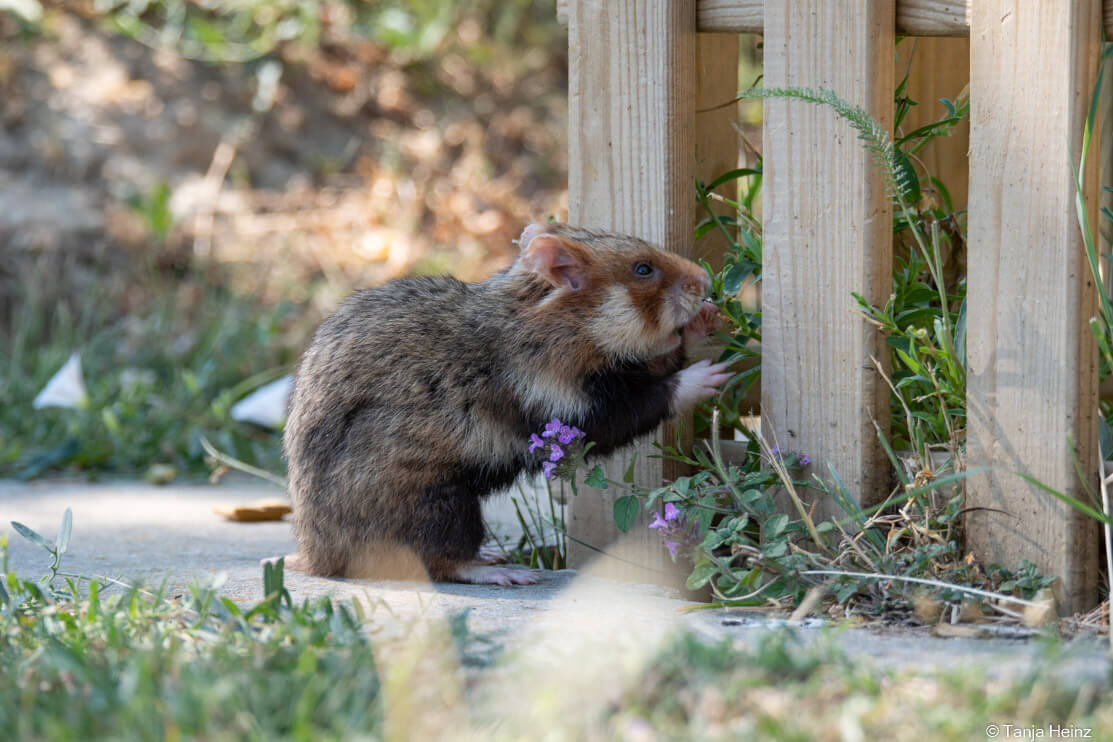
According to my experience at the Central Cemetery in Vienna, it might appear that the European hamster is a very abundant species. But be careful with my report! Although it might seem that European hamsters are very common, on a global level they are not!
In 2020, the IUCN declared the European hamster as “critically endangered” due to population declines caused probably by lower reproduction rates. The reason for these lower reproduction rates is still not clear. Is it because of the expansion of monoculture plantations? Or is it industrial development? Another reason for lower reproduction rates could also be global warming or light pollution.
The reason for these population declines is still not very clear and this requires further investigation.
But without conservation measures, European hamsters are expected to go extinct in the next 30 years according to the IUCN.
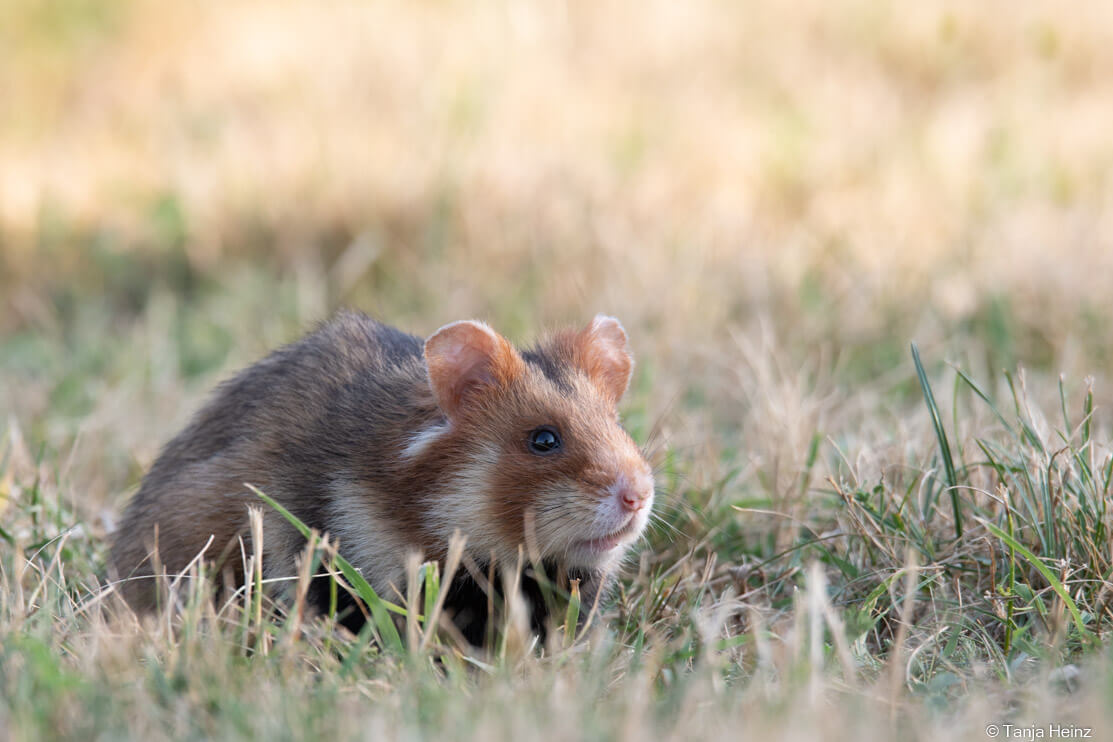
Important! Due to the fact that European hamsters are “critically endangered”, we have to be very careful with these animals. Please don’t disturb the animals. Keep a distance! As I haven’t seen any rules at the Central Cemetery, these animals especially rely on the responsibility of the visitors at the cemetery.
In this context I remembered the tour guide we had in the Pantanal. He told us that the hyacinth macaw is an abundant species, although it is listed as “vulnerable” on the Red List of the IUCN.
Again, many individuals of a species at one specific place does not necessarily mean that it is an abundant species on a global level!
How would the world look like without European hamsters and so many other species?

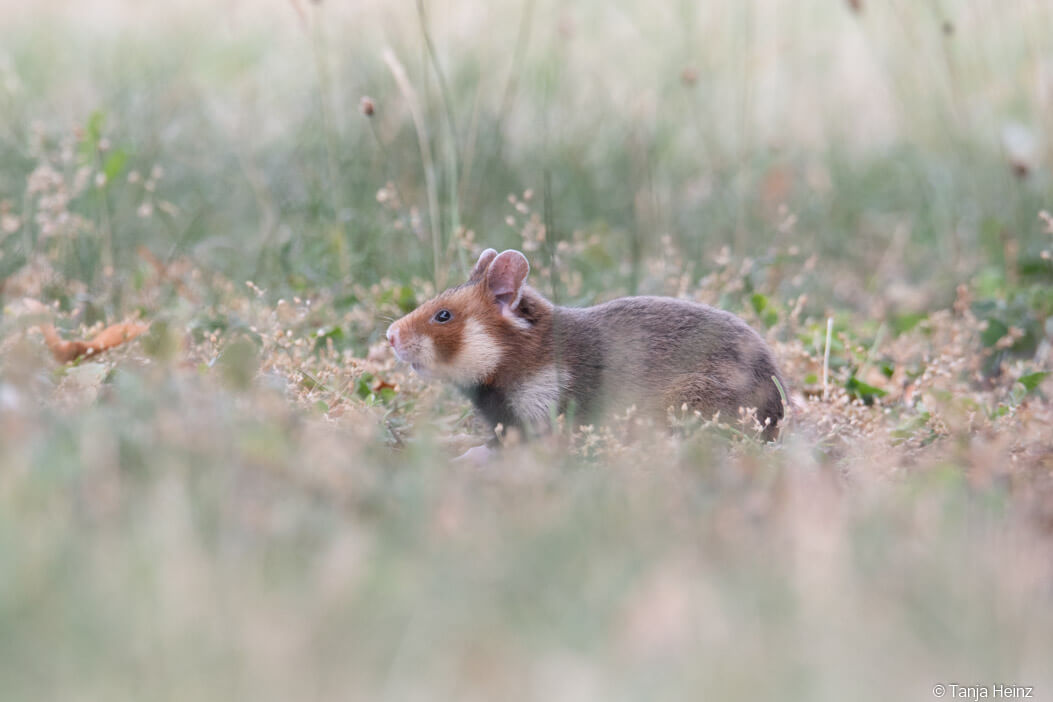
The world would be less colorful. Less beautiful. And more boring.
I’m always happy to see people enchanted by animals like European hamsters.
Even in situation when people do things which are - in my opinion - not good for the animals.
Well, I had such kind of a situation on my second visit at the Central Cemetery in Vienna.
I was sitting on the meadow waiting for the hamsters to show up. There were - as the other man told me - indeed quite many more hamsters.
Nevertheless, when I was sitting on the meadow with my camera, I observed a mum and probably a grandma together with two girls. Of course, they saw the hamsters as well and were delighted by the presence of these animals. However, they started to feed these little cute hamsters with sweets!
I couldn’t believe it!
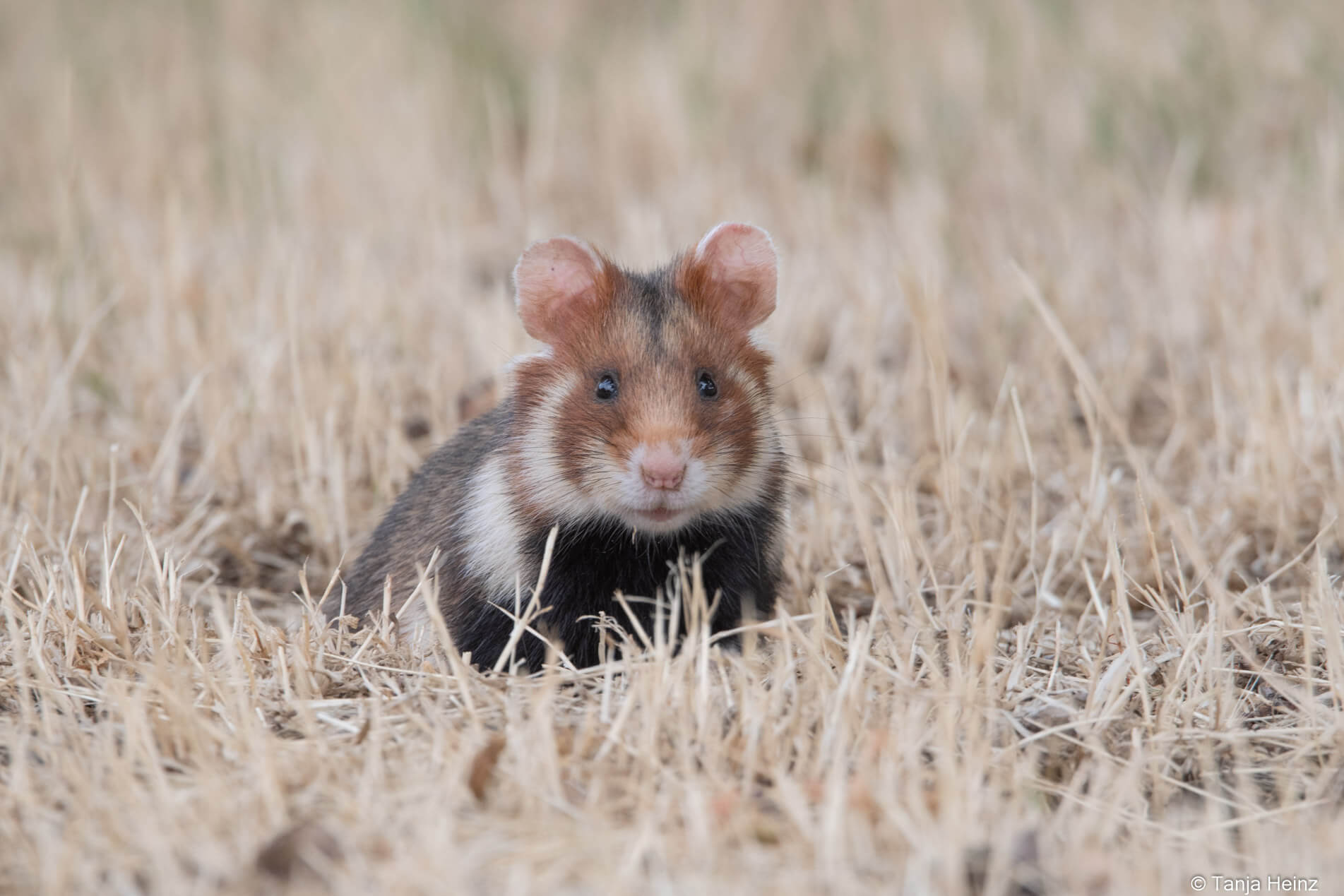
There was another wildlife photographer on the meadow.
Is he going to tell those people to stop feeding the hamsters with sweets? Could he see it?
In the first moment I was shy and I didn’t want to approach those people and talk about not feeding wild animals with sweets!
But I had to!
So I told them that European hamsters usually don’t feed on sweets.
The mum and the grandma just said "okay", and then, everyone was silent. Even the two girls. I felt somehow uncomfortably... I sensed that the two adults knew that feeding hamsters with sweets was wrong, but they let their girls do it! And now they felt caught unprepared.
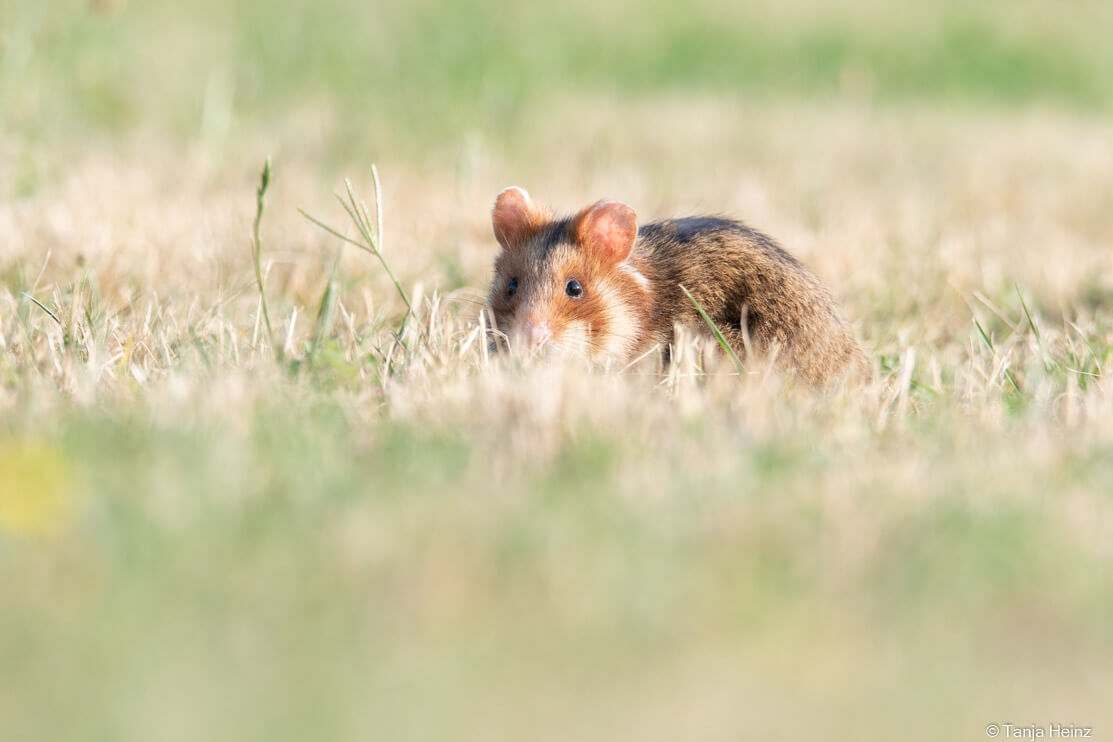
Important! Please don’t feed the European hamsters and any other wild animal with sweets! I understand very well that people want to get close interactions with wild animals, but feeding wild animals with sweets might actually harm them!
The girls as well felt uncomfortably. I didn’t want to act like a “police” or something like that. I didn’t think that I have the right to tell people what to do and what not to do. But feeding wild animals with sweets?
I really couldn’t understand it and I had to say something! I saw how a hamster carried a pink candy into its burrow!
Later I saw this other hamster searching for food in their bags. I didn’t say anything anymore and I stayed where I was.
As the cemetery is frequently visited by people, of course, the European hamsters become tamer and tamer.
I had a similar moment. I was barefoot on the meadow sitting or lying. In one moment, a hamster found my shoes exploring its inside.
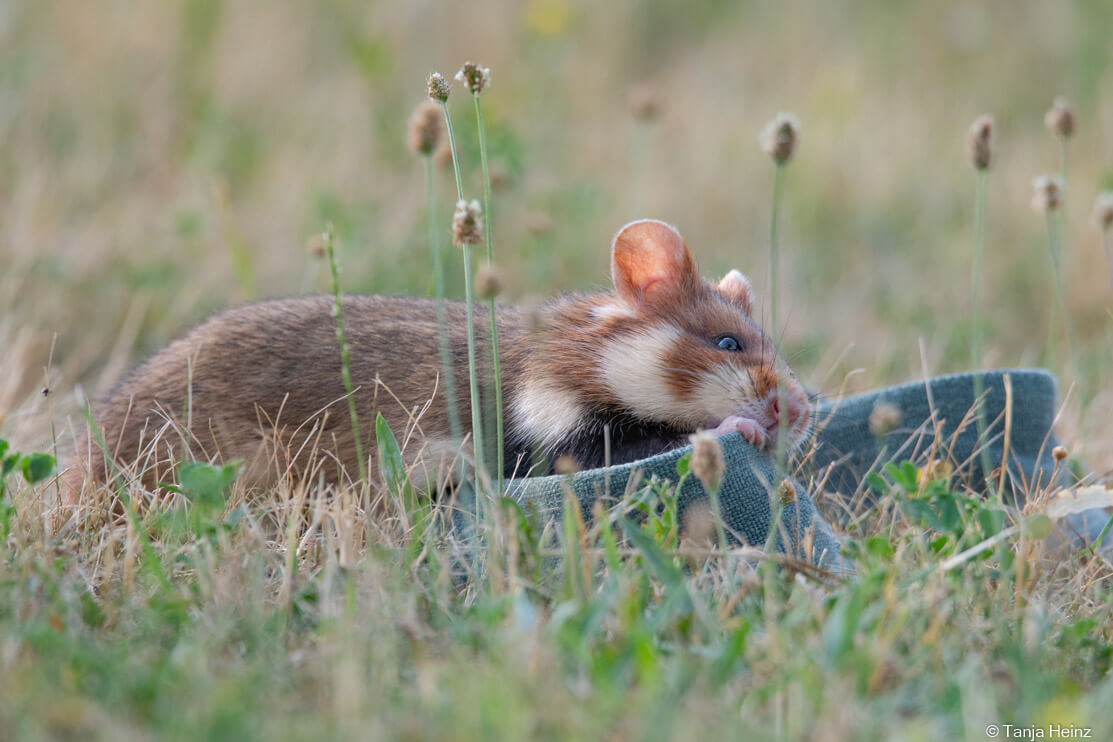
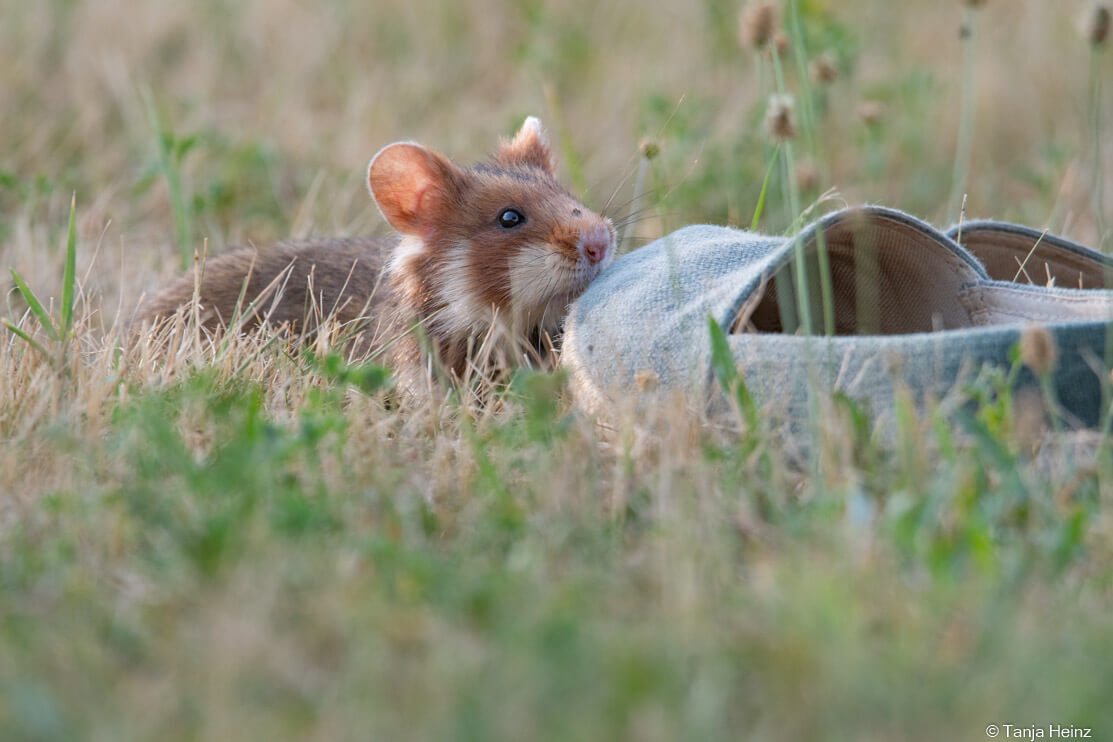
I just let it happen.
Yes, it is nice to have the European hamsters so close and I understand the other people’s joy for these animals!
But I didn’t feed them! Even if I would have had the idea of feeding the hamsters (I never would have done it anyway, unless it was recommended), I never would have given them sweets!
Nevertheless, there was one individual among the European hamsters, which was especially tame. It was a very sweet hamster!
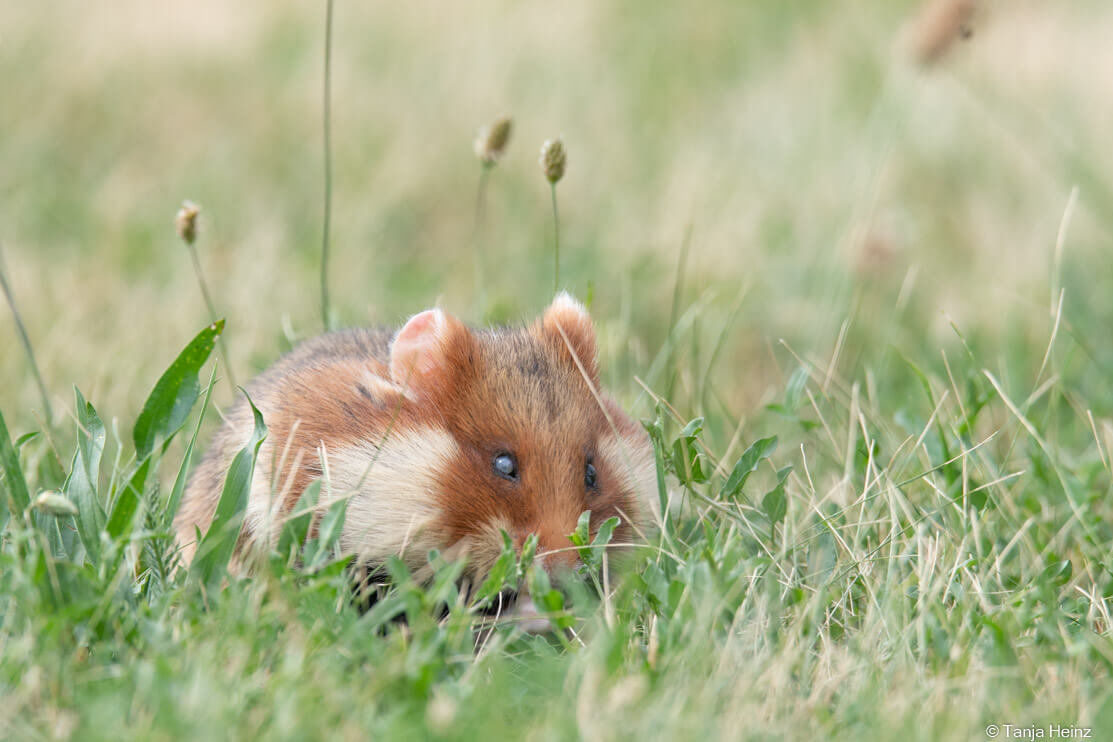
Just after some time I saw that it was probably a blind or rather half-blind individual!
How old was this hamster?
What does it mean for a hamster to be (half-)blind?
Doesn’t it have to be more cautious on the meadow because of all the predators?
That hamster didn’t appear to be more cautious than other hamsters. Rather the opposite was the case!
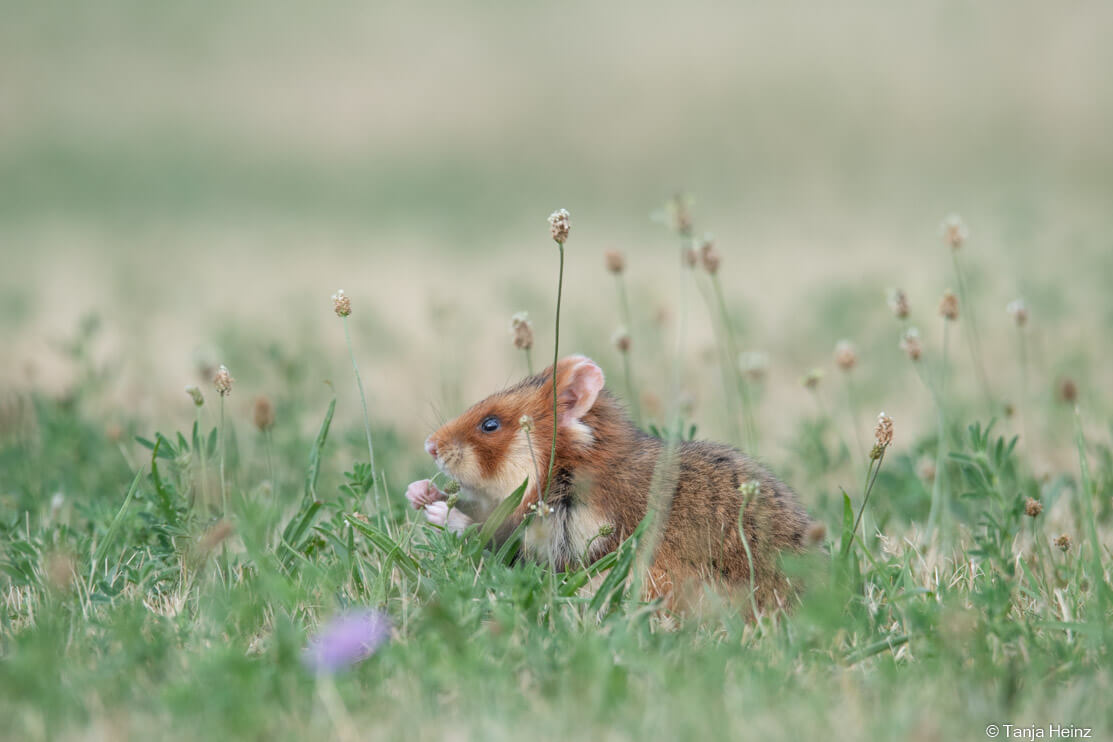

I was not sure at all if that hamster could detect me. It was such a tame individual and - as it seemed to me - careless. Well, I couldn’t do anything about that, except keeping a distance to that individual.
In the evening I had another great observation. I saw two adult European hamsters interacting.
What was it about?
Did they fight or did they play?
Does this happen every evening?
Unfortunately, I cannot tell anything more about that interaction. The interaction was too short. I furthermore had to keep a distance. It was difficult to get a reasonable photograph of them under the lower light conditions. It was already getting dark.
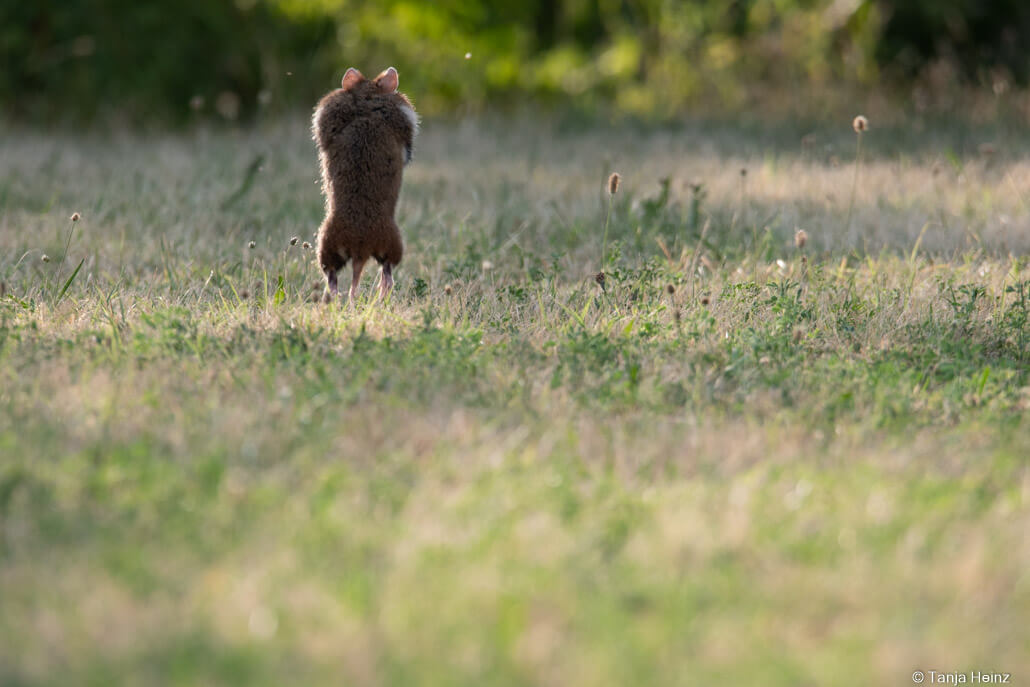
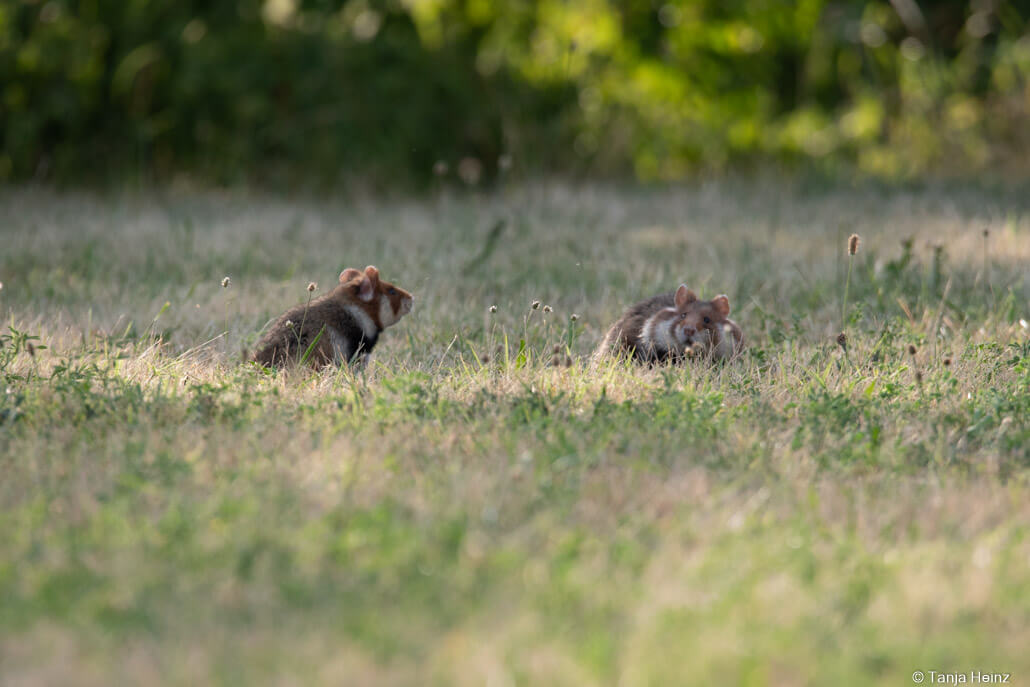
I finally thought that I had seen a lot of the European hamsters. Thus, after that fight (?) I decided to leave. Especially, the Central Cemetery was just about to close and I didn’t want to stay there overnight.
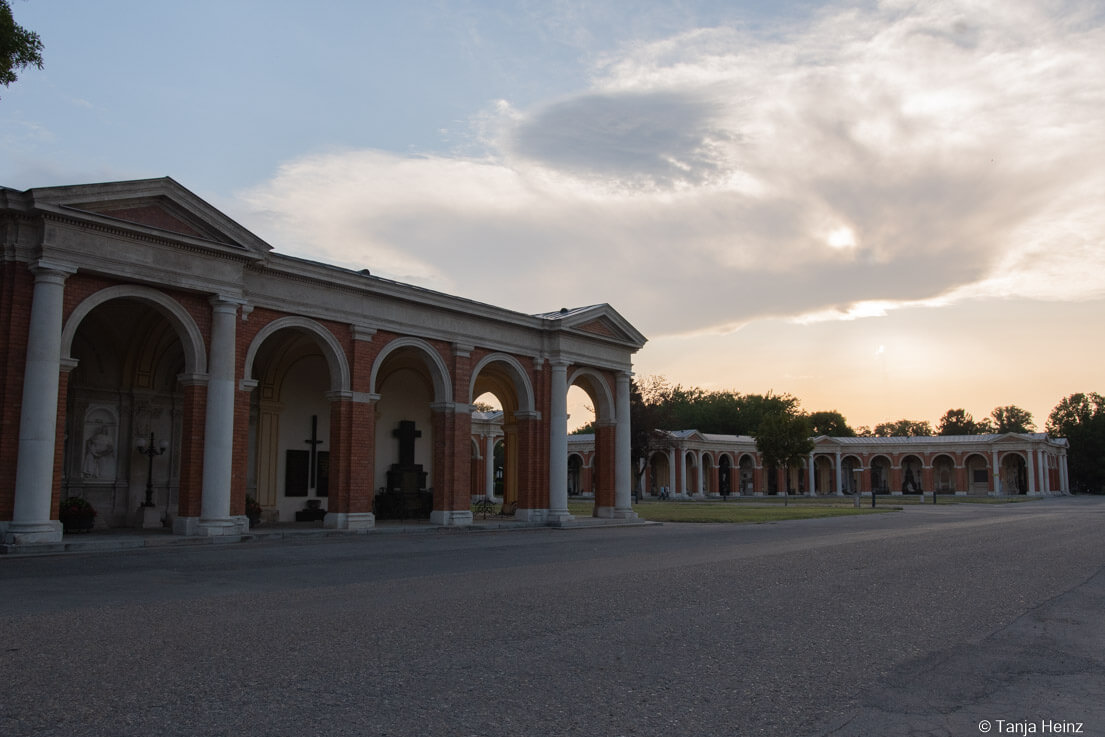
After two wonderful visits at the Central Cemetery, I really had wonderful sights of the European hamsters. I very wish to see this place again one day...
A species portrait: European hamsters
The European hamster Cricetus cricetus is the only species of the genus Cricetus. They are rodents and share the family Cricetidae with other hamsters, but also voles, lemmings, muskrats and New World rats and mice. All of them are rodents, and thus, belong to a very diverse order.
European hamsters have a chestnut-brown fur with white patches on the dorsal side. Their chests and bellies are black. The European hamster has a short tail, weighs typically less than 500g and has a size of about 40cm.
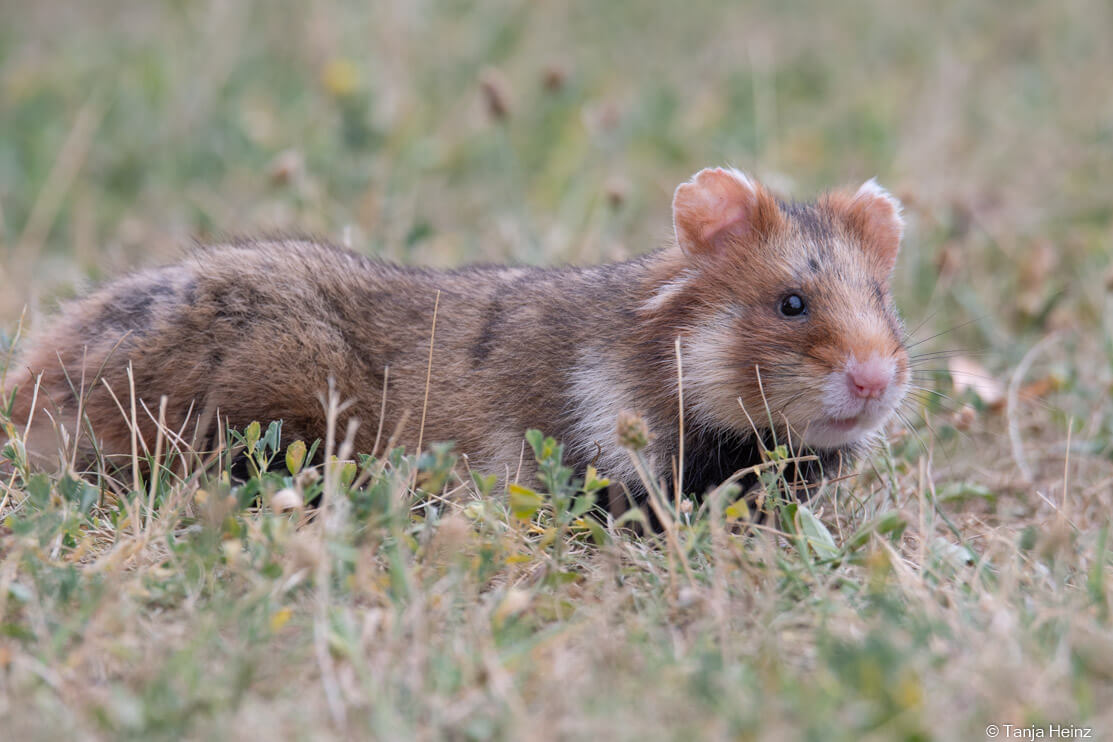
This rodent is a typical grassland dweller and occurs in large parts of Eurasia. From Belgium over other Central Europe states, Ukraine and Kazakhstan to Russia. They even might live in China. But this appears to be still uncertain.
Its wide distribution does not mean that the species is not under threat. Again, it is a “critically endangered” species and the population trend is - according to the IUCN - decreasing.
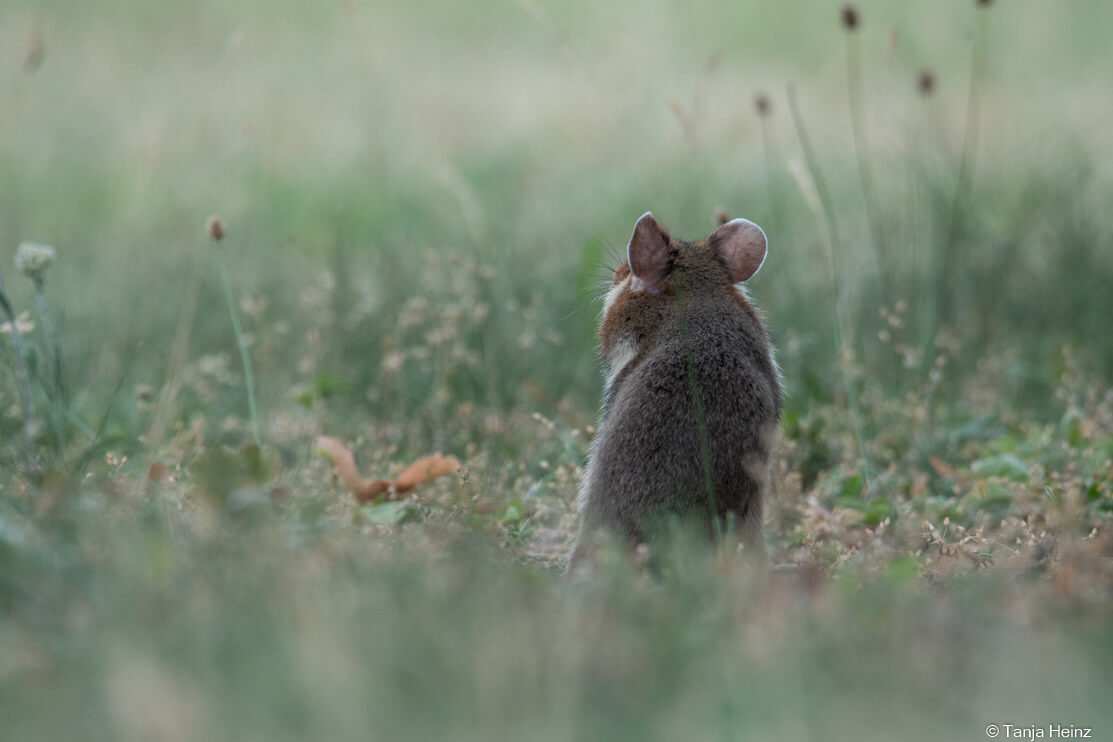
Interesting: Do you want to know more about how European hamsters in Vienna are influenced by disturbances like daily urban noise? Is there at all an influence? And do European hamsters have preferences with respect to the location of their burrows? What are their main activities in the mornings and evenings? Foraging or other activities? Please click on the study to learn more.
Interestingly, although I saw quite many European hamsters on the Central Cemetery in Vienna, this rodent is a solitary animal and engages in few social interactions.
As a nocturnal or crepuscular species, they are most active in the night or in the mornings and evenings, respectively. Due to the fact that more and more natural habitat of many wildlife species is being destroyed by human activities like agricultural practices and the expansion of urban area, how does this influence the behavior of animals like the European hamster on their daily activity ?
For example, according to a previous study, artificial light might affect the foraging behavior of European hamsters, and thus, might have an adverse effect on relocation, and thus, conservation efforts.
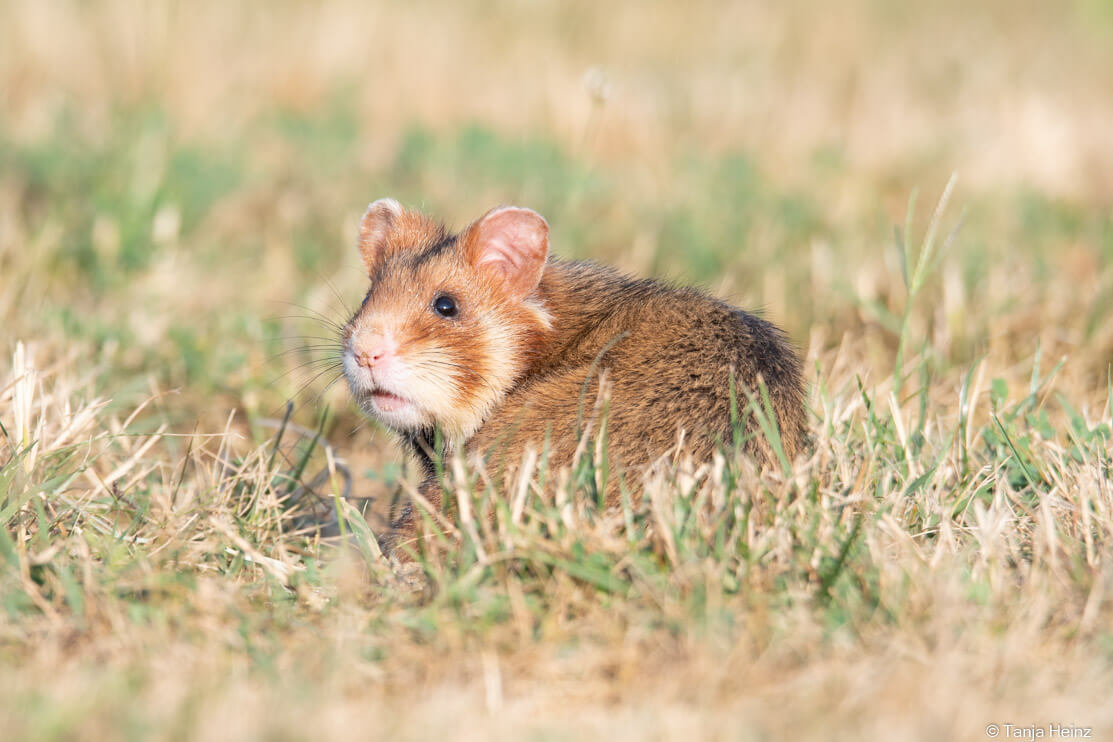
Unfortunately, the European hamster has so far not become a flagship species for conservation like orangutans or pandas. In the past, they were even considered as a pest.
I very hope that the photographs I took and the story I wrote have in some way a positive impact on European hamsters.
Tip: One other attraction in Vienna I very liked was the Blumengärten Hirschstetten. It is a nice place to enjoy nature. But it is also frequently visited by school or kindergarten groups. If you are looking for more wildlife in Vienna, there you will find the European ground squirrels.
Impressions of Vienna
Although my principal goal in Vienna was to visit the European hamsters and the European ground squirrels, I cannot leave this blog entry without showing some impressions of the city.
By all means, Vienna is beautiful for a city!
One of the most famous sights in Vienna is probably the Stephansdom.
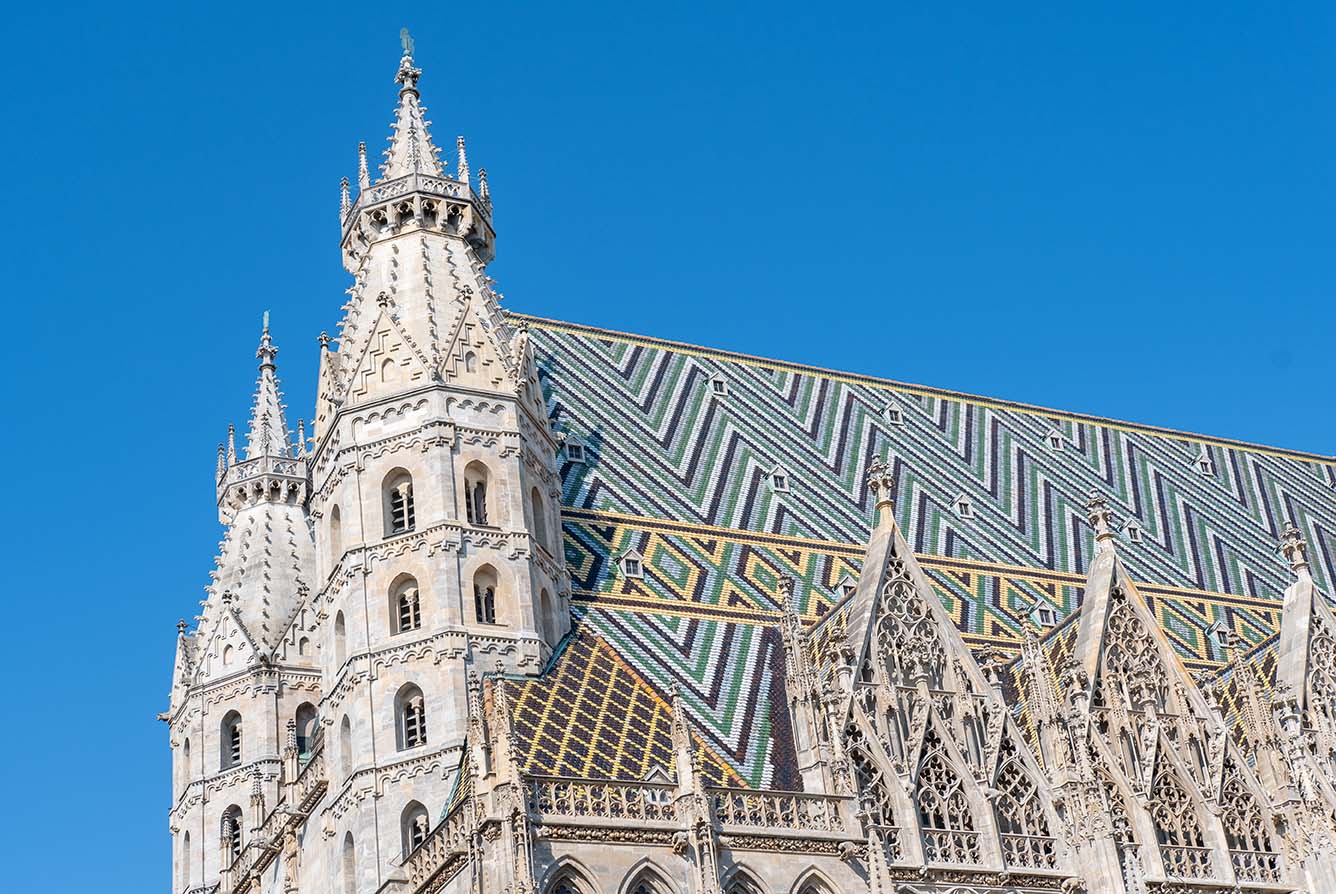
In Vienna I very enjoyed walking through the Old Town. But also walking along one of the main streets to admire all the large buildings.
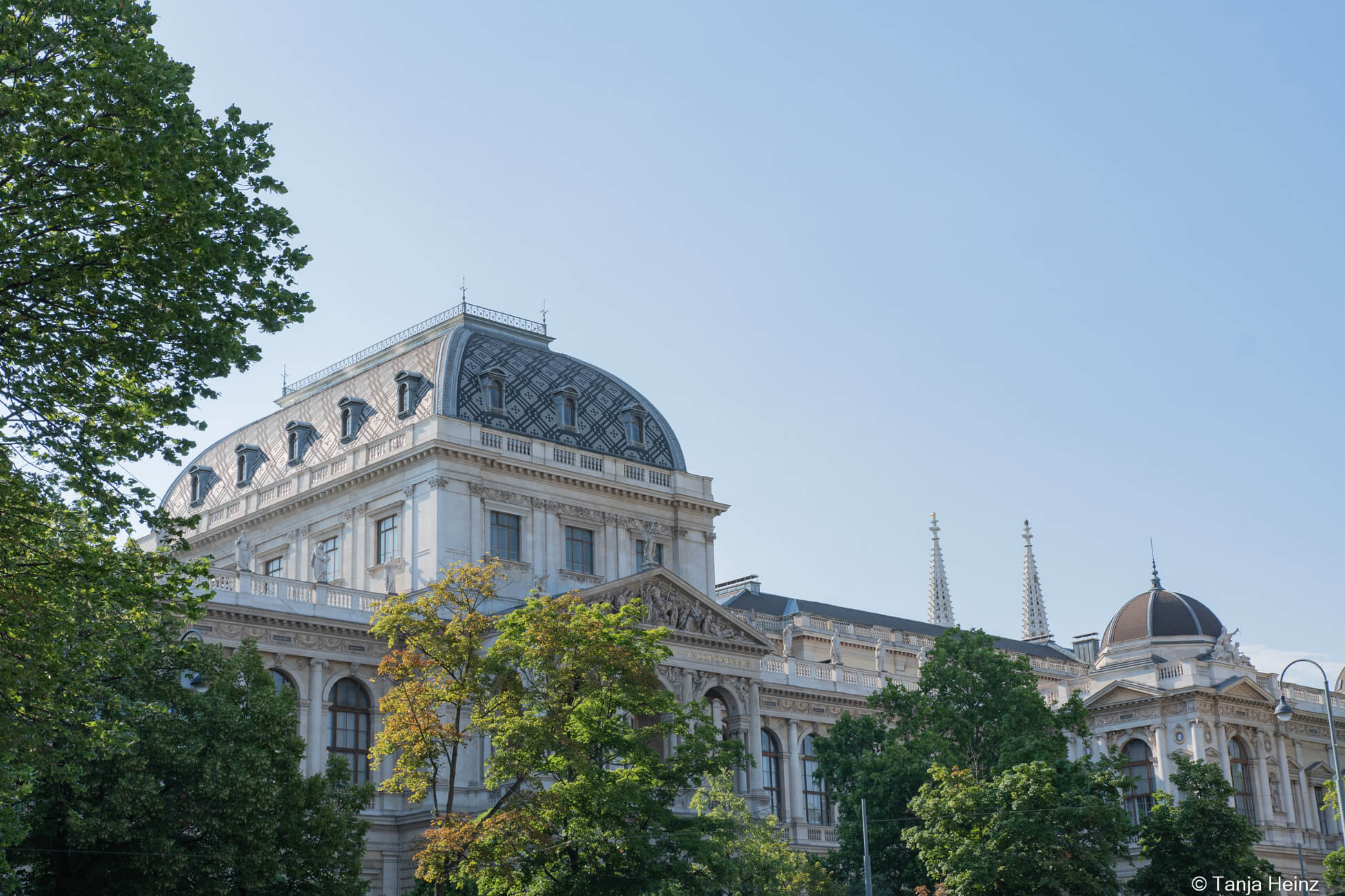
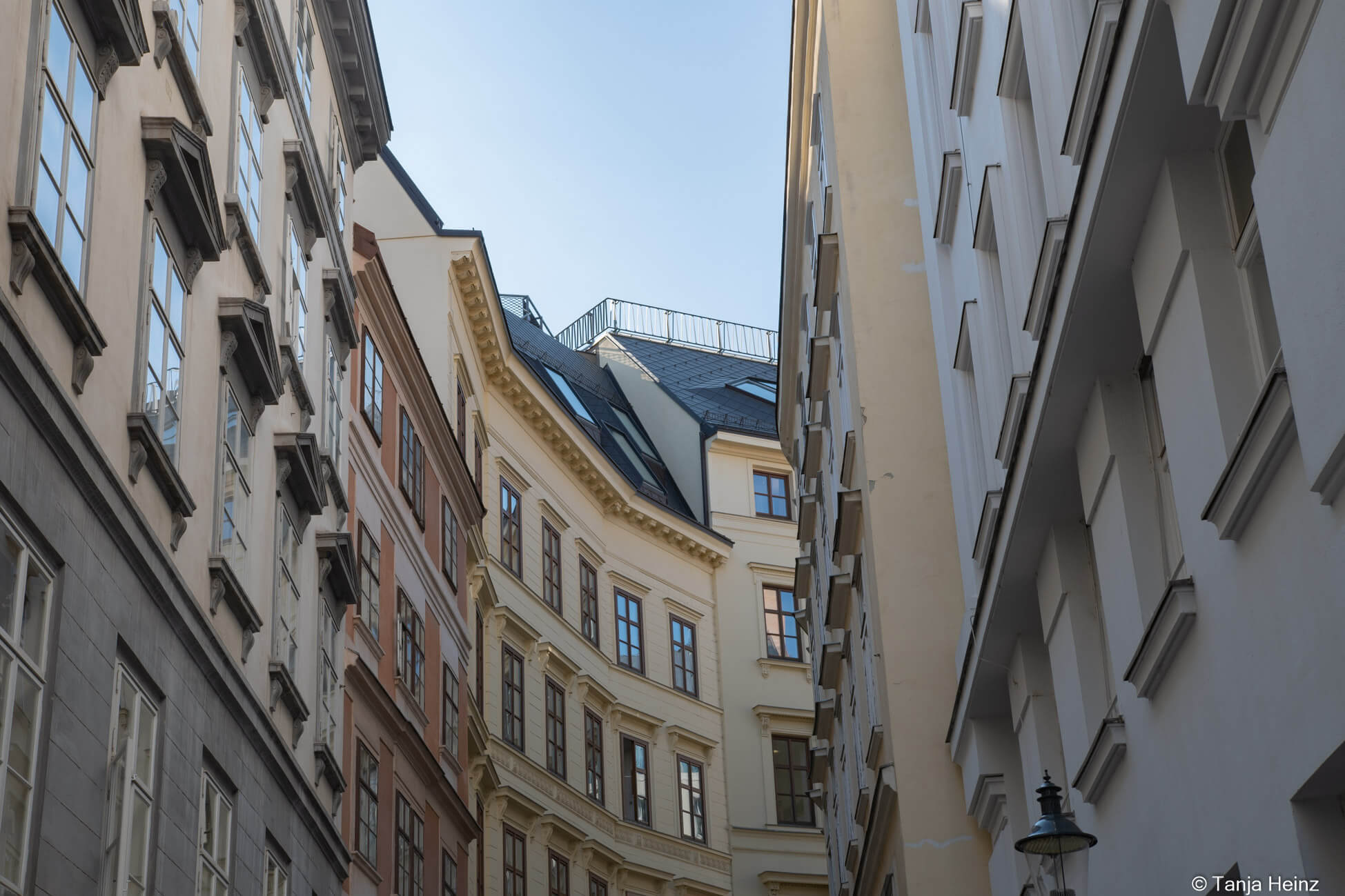
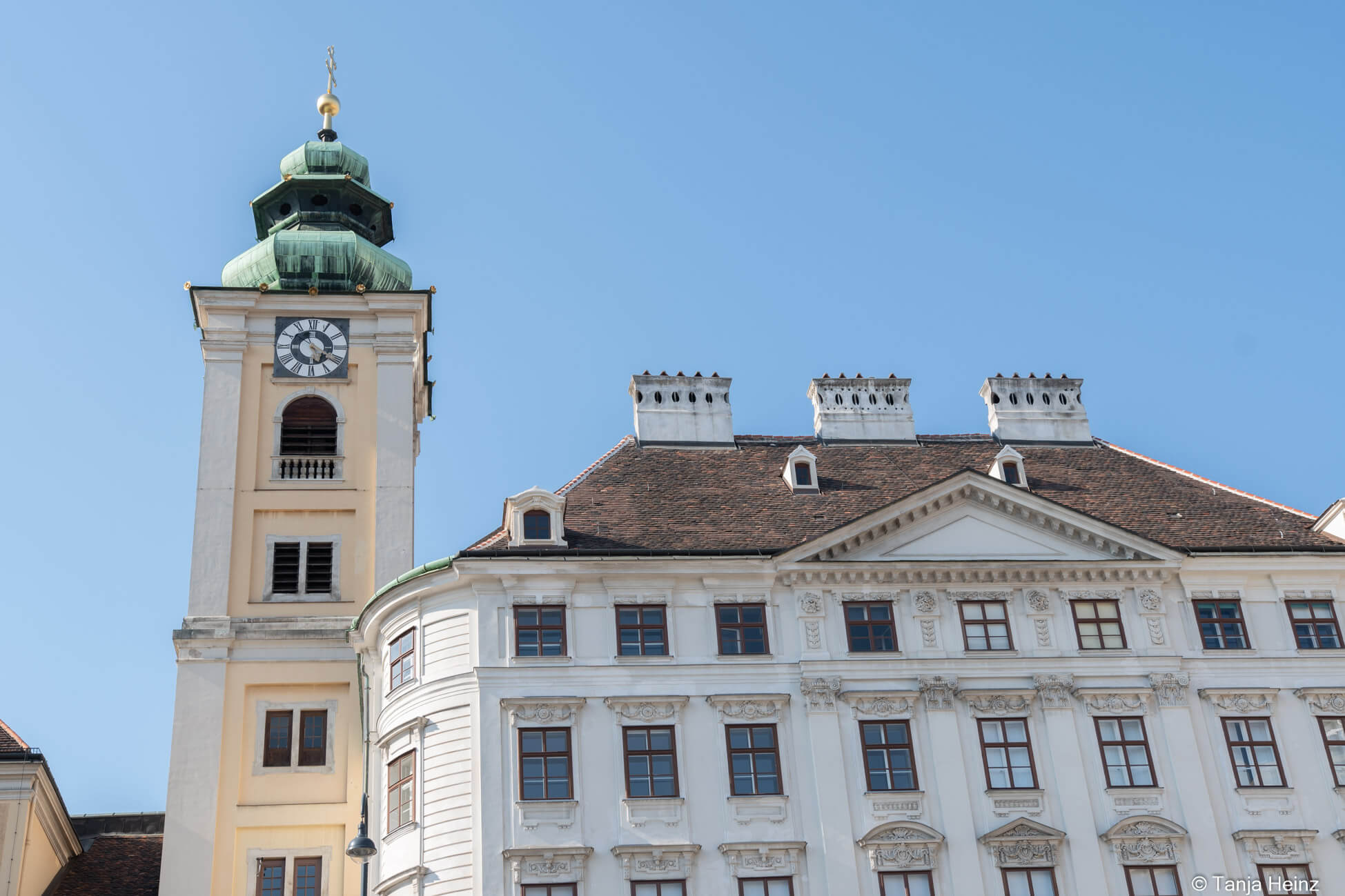

I give you here just a very tiny insight into the city of Vienna. However, as this blog is about wildlife, I want to keep myself short about all the other things you can do and see in the capital of Vienna.
Practical information
How to get to Vienna
I got to Vienna by train. As I stayed in the Allgäu, there were many train connections to Vienna. Please look on the website of the Deutsche Bahn to find a suitable train ticket.
In Vienna I bought a ticket for 72 hours. I paid 17,10 Euros. It was for me the best way to get around in the city. I bought the ticket at a ticket machine at a subway station. After voiding, the ticket was valid for 72 hours. Please check the website of the Wiener Linien to get the most up-to-date information.
Where to stay in Vienna
I stayed at the Time Out City Hotel in the street Windmühlgasse 6, 1060 Wien. I booked a single bedroom for four nights and paid 160,75 Euros. It was a nice and quiet room and just perfect for me as an accommodation in Vienna. No luxury or any additional needs. Just perfect for a short stay and for someone who is outside for most of the time.
Tip: Do you look for vegan food? I very enjoyed the food at the Simply Raw Bakery in the Drahtgasse 2. Good food and nice people. I also tried the vegan ice cream at Veganista in the Neustiftgasse 23. There are many more vegan options in Vienna. These were just my favorite ones.
More information about European hamsters
Studies about the European hamster
More about European hamsters (only in German)
Beautiful photographs of a wildlife photographer
More about wildlife in Vienna
The European hamster on Wikipedia
The Central Cemetery and other cemeteries in Vienna (only in German)
A report about the European hamsters in Vienna on National Geographic
Do you know the European hamsters at the Central Cemetery in Vienna? If yes, how do you feel about taking photographs at a cemetery? Please let me know your opinion in the comments!

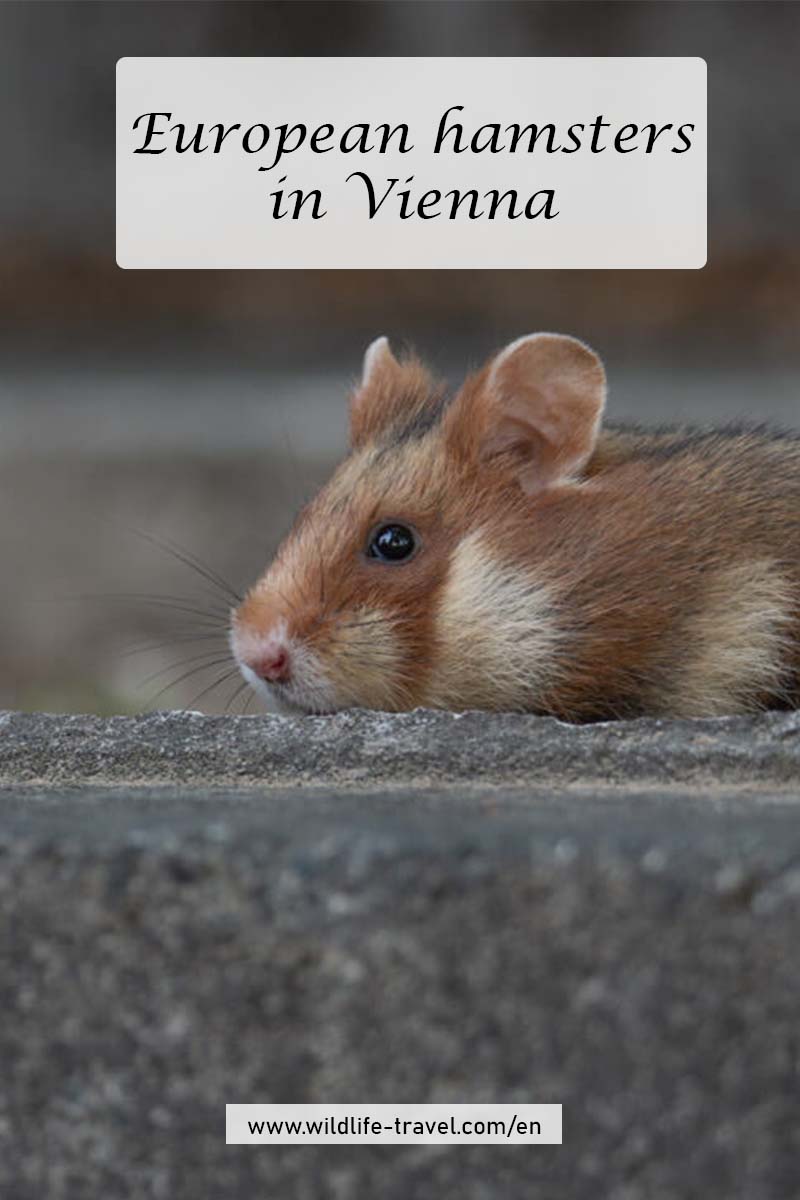

Thank you so much for this blog. My husband, 2 kids 8&10 years and I watched a documentary about the Vienna hamsters a couple a years ago. Decided to go, whenaver covid19 would let us. Now, we’ve been travelling the south of Europe for 5 weeks – we’ll reach Vienna in about a week or so.. So I was searching the web for more information – and found your blog. Amazing!!! And the tips for vegan food was just like cream on the cake 🙂 But one thing I couldn’t figure out – where did you go at night time to watch the hamsters? It seems to me that the central cemetary closes the doors at 17pm? Thanks again for a brilliant blog!
Dear Anne,
Thank you so much for your comment and your nice words 😀 I’m always happy to share my passion for animals and to hear that the information on the blog was helpful! Thanks so much!
The central cemetery is longer open than 5 p.m. From April to September the cemetery opens from 7 a.m. to 7 p.m. every day. From May to August the cemetery opens on every Thursday even until 8 p.m. You can check the opening hours on: https://www.friedhoefewien.at/unsere-friedhoefe#46-wiener-zentralfriedhof
Just click on Friedhöfe U-Z and than the first one “Wiener Zentralfriedhof”. However, it is unfortunately only in German.
On one Thursday I remained almost until 8 p.m. in the cemetery. As it was not possible to stay longer, I left and couldn’t observe the hamsters longer in the night. But still, the hamsters are very active in the evening hours.
I wish you a very, very good time with the hamsters! You and your family will have wonderful moments with them!
And if you want to see more animals… Another good place to watch adorable animals is Blumengärten Hirschstetten. In that area live several groups of European ground squirrels. It is also easy to access and to observe animals…
Thanks again for you kind words! 😀
Hi Anne
I was just wondering if you made it to see the hamsters!!? we are off next week!
I love this
I am hoping to visit with my young daughter.
Can you please tell me the best time of year to see them active?
Thank you
Thank you very much for your comment 🙂
I was in Vienna in the summer months, in July. As hamsters hibernate during the winter months, the best time to see them is in summer. I cannot tell when exactly they appear in spring/summer, but I’m sure that you have good chances in June, July and August. I hope this helps.
Kind regards,
Tanja
Thank you so much! we will be travelling very soon. Do you think by September they will still be active?
Thank you so much for all your information and amazing pictures x
Thank you so much for your comment and telling me that the information was helpful for you 🙂
Unfortunately, I do not know if the hamsters in the cemetery are still active in September. But they really might be as they start hibernating in autumn. I would be very happy if you could tell me your experience with the hamsters in September in Vienna here. I’m sure that more people would be happy to have this information 😉
Kind regards,
Tanja
Hi
Thanks for such an amazing post! Do you know if it needs to be sunny for the hamsters to be active or are they also out on cloudy and rainy days? Thanks
Hi Kim,
thank you very much for your comment! I’m very happy that you liked it 😀
That is a really good question! Unfortunately, as I do not live in Vienna, it is difficult to tell if the hamsters are active on cloudy and rainy days. I would think that the hamsters should come out to search for food… however, I found a study from the Netherlands which says that heavy rain might directly cause pneumonia in hamster, and thus, I would think that they might be more cautious on rainy days? However, this is just a guess… The link of this study is:
https://www.researchgate.net/publication/254897357_European-wide_conservation_of_the_common_hamster_cricetus_cricetus_What_do_we_need_to_know
I hope this helps a little bit. If you have found an answer, I would be very happy to hear about it! Thanks so much 🙂
Best wishes,
Tanja
Hello.
Thanks very much for this.
Last month I visited Vienna from the UK to look for wildlife in and around the city, and I used mostly information from this post and from your post about the European Ground Squirrels. Your blog has been very helpful to me.
I wrote about my trip in two parts here if you’re interested:
https://voleexplosion.com/2023/05/26/hamster-hunting-in-vienna/
https://voleexplosion.com/2023/05/29/walking-to-slovakia/
I also provided links to your posts.
Thanks again,
Carlos
Thank you so much Carlos for your comment! I am always very happy when my blog is useful for planning a wildlife encounter 😀
And thank you as well for the acknowledgement in your post and the link of your trip to Vienna and the hamsters! Really good to hear about that 😀
In your blog post I see that you have seen quite many birds! I will have a closer look at your post 🙂 and thanks again!
Have a good day!
Tanja
we are. here now! the cemetery is sooo vast. Can anyone tell me a specific area? I know they cant be tracked but a rough idea?
Dear Sara,
you can try to enter gate 1 or 2. I think both gates are a good choice. I planned to enter at gate 1, but as I missed to get out the tram at that tram station, I got out at gate 2 (this is the main gate). I didn’t have to wait long to see the hamsters. I actually just entered the park and within a few minutes I saw the first hamsters. But it was early in the morning. You can also try the evening. But check the opening hours…
Have a good time!! 🙂
Thank you for a great report and the lovely photographs! I’m visiting Vienna next week and your tips will be really helpful 🙂 I’m looking forward to seeing red squirrels, European ground squirrel, but of course most of all the hamsters in the cemetery!
Btw, I don’t think people will have a problem with you taking photos in a cemetery. Cemeteries are often great for wildlife, and people will find comfort in their loved ones being surrounded by nature 🙂
Hello Nik,
thank you very much your comment 🙂
I’m sure that you will have great wildlife encounters in the cemetery next week. The cemetery in Vienna is just a great spot to see and photograph wildlife. And this in a city like Vienna 😉
And thank you very much for sharing your thoughts about going to a cemetery to photograph wildlife. I was indeed a little bit worried, but I was relieved that the people there didn’t seem to have a problem with that. I very like your thought “people will find comfort in their loved ones being surrounded by nature”.
I wish you a great time in Vienna and the wildlife you see in the cemetery and there elsewhere 🙂
Best wishes,
Tanja
😀
Hello and thank you very much for the kind and detailed story about European hamsters! You write so well that I feel like I have visited the hamsters myself (to visit them in reality is my dream). European hamsters need protection, so any positive mention of them and wonderful photos emphasizing their beauty speaks in their defense!
Thank you very much again.
Hi Iya,
Thank you so much for your comment! I’m really happy that you like European hamsters and my blog post. 😀
I truly hope you get the chance to see European hamsters in real life one day!
Your comment means a lot to me — it shows me that my blog is reaching people, and that really motivates me to keep writing about all the special animals out there. ❤️
Thanks again for your kind words!
Wishing you a wonderful day,
Tanja
❤
Hi Tanja,
Thank you so much, that was a great read about the hamsters. Funnily I live in Vienna and was just looking for information on where to find them as someone from the UK said that this would be the first thing he’d do when he would visit Vienna.
Being an environmentalist, I try to explore the beauty around me rather than fly to far away locations, so I was looking for anything I could do in and around Vienna or Austria.
Long story short: a question please: where was that second spot with even more hamsters that the other photographer recommended? When I look at google maps, I see three squares of open grassland between gate 1 and 2. Are any of these the recommended spot?
Interstingly one of them is close to the grave of my wife’s grandmother. So on another note: I don’t think anyone would bother you photographing wildlife on a graveyard. “Street photography” would be a totally different thing, but wildlife is absolutely fine IMO – particularly in the “Zentralfriedhof” ;).
Thanks again,
Wolf
Hello Wolf,
thank you so much for your comment. I’m very happy that you enjoyed reading about the hamsters 🙂
I think you are very lucky to live in Vienna. Vienna is a big city, but still has so much wildlife to explore. The hamsters are indeed very special. I’m sure there are more people like the person from the UK and me that put the hamsters on top of everything in Vienna.
When I was in the Zentralfriedhof I entered gate 2 and I didn’t have to search for the hamsters. I saw immediately one. When you enter gate 2 and turn left, you might see many hamsters there on the grass as well. At least I spent quite a long time there. However, I have been in the central cemetery in 2022, so the hamsters might change their distribution within in the central cemetery over the years. And now is November. I was in the central cemetery in July. In autumn/winter they should hide and hibernate. I have never been in the central cemetery in autumn/winter, but I would expect not to see hamsters at the moment. But as you live in Vienna, you can easily explore them in the next spring.
I hope I could help you and thanks again for reading and commenting 🙂 ,
Tanja